Quotations in Context
In the Convergence article series “HoM Toolbox, or Historiography and Methodology for Mathematicians,” on the page “Introduction - How Do We Know About the Past?”, Amy Ackerberg-Hastings reminds the reader that sources of historical information can be broken into primary, secondary, and tertiary sources. Articles aimed at an audience of fellow scholars in a given field will be careful to emphasize primary sources. In contrast, it is an unfortunate fact that many of the mathematical quotations circulated on the internet or in publications aimed at a general audience tend to come from tertiary sources; that is, they rarely are drawn from direct examinations of the works of the attributed authors, and in fact such quotations are often shared without any mention of the primary sources in which they originally appeared.
Because mathematical quotations are so often drawn from tertiary sources, it is not surprising that frequently they have been changed in the course of passing through many hands. Sometimes the name of the original author is lost and the quote becomes misattributed to a different author. In other cases, the wording may be changed, becoming a misleading paraphrase of the original author’s intent. Even if the author and quotation are accurate, words stripped from their original setting can appear to mean something very different than when they are viewed in the context of the surrounding material.

Finding the original source of a mathematical quotation can be described as
creating a bibliographic trail, akin to this path around Prescott Fields at
the University of Maine at Farmington. Photo by UMF, supplied to Maine Trail Finder.
In 2006, I started writing a regular column called “Quotations in Context” which appeared in the biannual CSHPM/SCHPM Bulletin of the Canadian Society for History and Philosophy of Mathematics. Each column examined one or more related quotations, tracking them to their first appearances in primary sources whenever possible. These past columns, revised and updated, will now be available as a resource here on Convergence. These columns contain interesting details that might be included by teachers where appropriate in the mathematics classroom. They also represent a way to prompt students to think about and discuss the potential problems that arise from too much reliance on tertiary sources.
For mathematics educators who wish to involve their students in historical research, these columns could also be viewed as examples/templates of a usefully-bounded student project. A growing number of archives of primary historical materials have become available online, not just to scholars in specialized fields, but as well to teachers, students, and the general public at no cost: the Cambridge Digital Library, e-rara, Google Books, the HathiTrust Digital Library, the Internet Archive, the Linda Hall Library Digital Collection, and the University of Michigan Historical Mathematics Collection, to name only a few. While there still exist some barriers, such as language, to the exploration of these materials, it nonetheless remains quite possible for more advanced students to take quotations they have found in tertiary sources and successfully track that information back to their primary sources; in addition, even if students are unable to find the original source, they could still gain valuable experience by writing a detailed explanation of their work tracing the quotation back as far as they were able to go. Researching a single quotation could also help familiarize students with the vast online archives available to them; in particular, such a task could serve as preparation for more significant research projects.
Quotations in Context: Adams
“I must study politics and war that my sons may have liberty to study mathematics and philosophy. My sons ought to study mathematics and philosophy, geography, natural history, naval architecture, navigation, commerce, and agriculture in order to give their children a right to study painting, poetry, music, architecture, statuary, tapestry, and porcelain.”
In 1780, John Adams returned to Paris as the new minister empowered by the Continental Congress to negotiate treaties concerning both peace and trade with Great Britain. Since such negotiations would not take place for several years, Adams found himself somewhat at loose ends immediately after his arrival. Among other things, he spent some of his time in seeing the sights of Paris. Unlike his previous mission, when he had arrived in France unable to speak the language and had lived on the outskirts of Paris with Benjamin Franklin, Adams was now residing in the center of Paris at the Hôtel de Valois, close to the Palais Royal and Tuileries gardens.

Painting of John Adams by Gilbert Stuart. Public domain, National Gallery of Art.
Over the course of the spring, Adams sent dozens of letters back to his wife Abigail, who had remained in Braintree, Massachusetts. In a letter posted on May 12, he described some of his explorations:
To take a Walk in the Gardens of the Palace of the Tuileries, and describe the Statues there, all in marble, in which the ancient Divinities and Heroes are represented with exquisite Art, would be a very pleasant Amusement, and instructive Entertainment, improving in History, Mythology, Poetry, as well as in Statuary. Another Walk in the Gardens of Versailles would be useful and agreeable [Adams 1780].
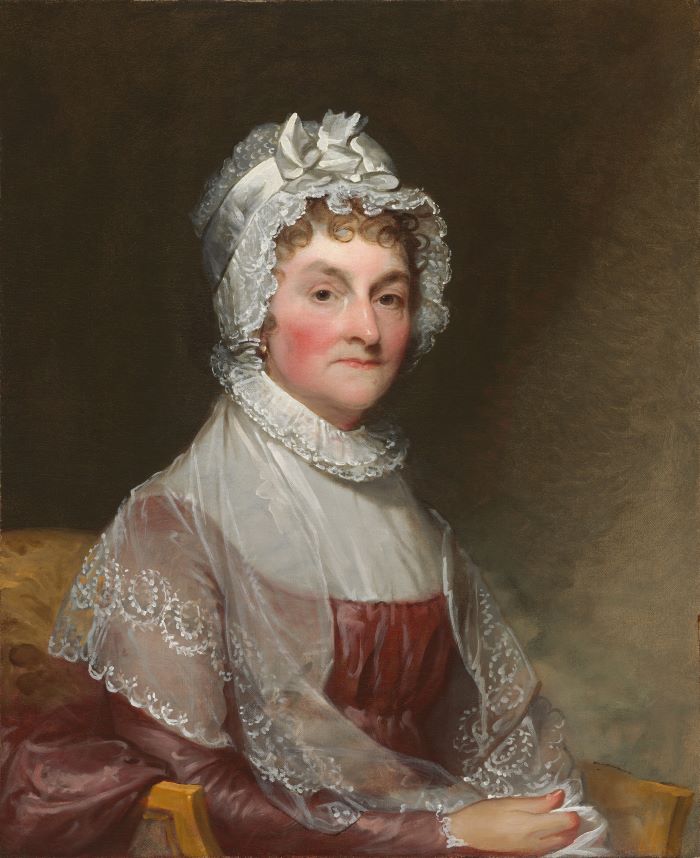
Painting of Abigail Adams by Gilbert Stuart. Public domain, National Gallery of Art.
However—not surprisingly given Adams’ temperament—he would have greatly preferred to be spending his time on more important and productive tasks:
But to observe these Objects with Taste and describe them so as to be understood, would require more time and thought than I can possibly Spare. It is not indeed the fine Arts, which our country requires. The Usefull, the mechanic Arts, are those which We have occasion for in a young Country, as yet simple and not far advanced in Luxury, altho perhaps much too far for her Age and Character.
I could fill Volumes with Descriptions of Temples and Palaces, Paintings, Sculptures, Tapestry, Porcelaine, &c. &c. &c. -- if I could have time. But I could not do this without neglecting my duty. The Science of Government it is my Duty to study, more than all other Sciences: the Art of Legislation and Administration and Negotiation, ought to take Place, indeed to exclude in a manner all other Arts [Adams 1780].
It is at this point that the subject quotation of this column appears. Interestingly, the letter shows that the reference to mathematics was not part of his initial draft of the statement. In the letter, the first sentence of the quotation originally began, “I must study Politicks and War that my sons may have liberty to study Painting and Poetry” [Adams 1780]. However, Adams drew a line through “Painting and Poetry” and replaced it with the familiar “Mathematicks and Philosophy” instead.
The complete contents of this letter can be found in the Adams Family Papers electronic archive maintained by the Massachusetts Historical Society. In addition to the correspondence between John and Abigail Adams, the archive also contains Adams’ (incomplete) autobiography as well as parts of his journals.
Reference
Letter from John Adams to Abigail Adams, post 12 May 1780 [electronic edition]. Adams Family Papers: An Electronic Archive. Massachusetts Historical Society, https://www.masshist.org/digitaladams/archive/.
“Quotations in Context” is a regular column written by Michael Molinsky that has appeared in the CSHPM/SCHPM Bulletin of the Canadian Society for History and Philosophy of Mathematics since 2006 (this installment was first published in November 2009). In the modern world, quotations by mathematicians or about mathematics frequently appear in works written for a general audience, but often these quotations are provided without listing a primary source or providing any information about the surrounding context in which the quotation appeared. These columns provide interesting information on selected statements related to mathematics, but more importantly, the columns highlight the fact that students today can do the same legwork, using online databases of original sources to track down and examine quotations in their original context.
Quotations in Context: Copernicus
“Mathematics is written for mathematicians.”
In his preface to De revolutionibus orbium coelestium (On the revolutions of the heavenly spheres), Nicolaus Copernicus described his reasons for hesitating to publish his work. He admitted to fearing the ridicule of others, but finally decided that those mostly likely to heap scorn upon his work were those who are least qualified to judge it. It is at this point in the preface that the phrase “Mathemata mathematicis scribuntur” [Copernicus 1543, p. vii] appears.
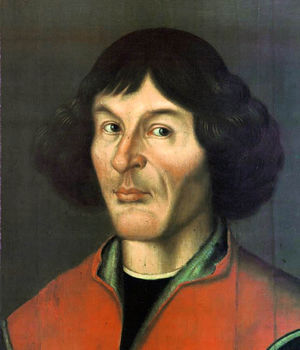
Painting of Copernicus, 1580. Public domain, Convergence Portrait Gallery.
Unfortunately, the Latin here is potentially ambiguous, with the same words sometimes used to refer to astronomy or even astrology, rather than mathematics. Historian Dorothy Stimson translated the preface as part of her 1917 doctoral dissertation at Columbia University, The Gradual Acceptance of the Copernican Theory of the Universe. In her text, the words were consistently translated as references to mathematics:
If perchance there should be foolish speakers who, together with those ignorant of all mathematics, will take it upon themselves to decide concerning these things, and because of some place in the Scriptures wickedly distorted to their purpose, should dare to assail this my work, they are of no importance to me, to such an extent do I despise their judgement as rash. For it is not unknown that Lactantius, the writer celebrated in other ways but very little in mathematics, spoke somewhat childishly of the shape of the earth when he derided those who declared the earth had the shape of a ball. So it ought not to surprise students if such should laugh at us also. Mathematics is written for mathematicians [Stimson 1917, p. 115].
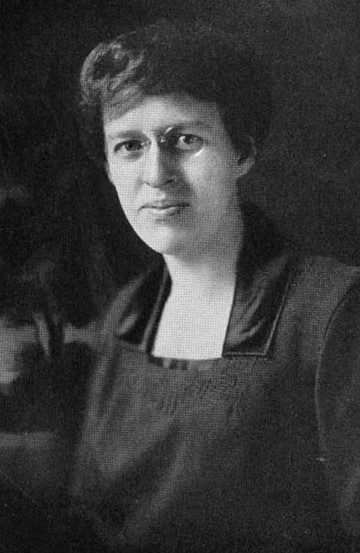
Photograph of Dean Dorothy Stimson, 1926. Donnybrook Fair Yearbook Collection,
Goucher College Digital Library, Goucher College Archives, Towson, MD.
On the other hand, a more recent translation by historian Edward Rosen consistently interpreted the Latin in terms of astronomy instead:
Perhaps there will be babblers who claim to be judges of astronomy although completely ignorant of the subject and, badly distorting some passage of Scripture to their purpose, will dare to find fault with my undertaking and censure it. I disregard them even to the extent of despising their criticism as unfounded. For it is not unknown that Lactantius, otherwise an illustrious writer but hardly an astronomer, speaks quite childishly about the earth’s shape, when he mocks those who declared that the earth has the form of a globe. Hence scholars need not be surprised if any such persons will likewise ridicule me. Astronomy is written for astronomers [Copernicus 1978, p. 5].
Which of these translations interprets “Mathemata mathematicis scribuntur” correctly? Interestingly, that very issue seemed to be addressed by Copernicus in the introduction of Book I. Copernicus began by arguing that, of all things that can be studied, nothing is more important than the study of the heavens and the movements of the stars. Copernicus explicitly recognized the ambiguity of how this study has been named:
If then the value of the arts is judged by the subject matter which they treat, that art will be by far the foremost which is labeled astronomy by some, astrology by others, but by many of the ancients, the consummation of mathematics. Unquestionably the summit of the liberal arts and most worthy of a free man, it is supported by almost all the branches of mathematics. Arithmetic, geometry, optics, surveying, mechanics and whatever others there are all contribute to it [Copernicus 1978, p. 7].
If the study of the stars is truly to be viewed as the “consummation of mathematics,” arguing about the distinction between “Mathematics is written for mathematicians” and “Astronomy is written for astronomers” appears somewhat unimportant.
References
Copernicus, Nicholas. 1543. De revolutionibus orbium coelestium. Nuremberg: Johann Petreius.
Copernicus, Nicholas. 1978. On the Revolutions. Translation and commentary by Edward Rosen. Edited by Jerzy Dobrzycki. Vol. 2. London: Palgrave Macmillan.
Stimson, Dorothy. 1917. The Gradual Acceptance of the Copernican Theory of the Universe. New York: Baker & Taylor.
“Quotations in Context” is a regular column written by Michael Molinsky that has appeared in the CSHPM/SCHPM Bulletin of the Canadian Society for History and Philosophy of Mathematics since 2006 (this installment was first published in May 2008). In the modern world, quotations by mathematicians or about mathematics frequently appear in works written for a general audience, but often these quotations are provided without listing a primary source or providing any information about the surrounding context in which the quotation appeared. These columns provide interesting information on selected statements related to mathematics, but more importantly, the columns highlight the fact that students today can do the same legwork, using online databases of original sources to track down and examine quotations in their original context.
Quotations in Context: Coveyou
“The generation of random numbers is too important to be left to chance.”
In 1967, the annual meeting of the Society for Industrial and Applied Mathematics was held in Washington, DC. The program for the meeting included a symposium on applied probability and Monte Carlo methods, which was sponsored by the Air Force Office of Scientific Research. As part of the symposium, Robert Coveyou from Oak Ridge National Laboratory presented an invited paper entitled “The Mathematics of Random Number Generators.” A revised version of the paper was included in Studies in Applied Mathematics 3, published by SIAM in 1969. The paper evaluated the strengths and weaknesses of random number generators, specifically those methods that could be easily implemented by computer.
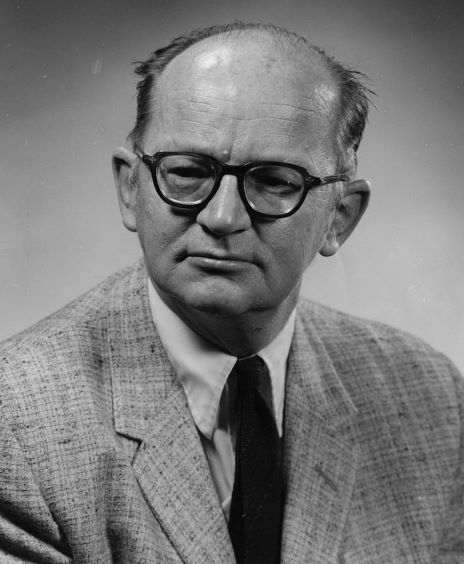
Photograph of Coveyou. Smithsonian Institution Archives.
Although the title of the original talk was somewhat prosaic, the revised, published version of the paper was given the more humorous title, “Random Number Generation is too Important to be Left to Chance” [Coveyou 1969, p. 70]. This title appears to be the source of the more common, slightly paraphrased statement that appears at the beginning of this column, since the author never used any similar wording throughout the body of the paper. So in the case of this quotation, there is in a sense no surrounding context; instead, it appears to have been intended as a clever, eye-catching title to draw the reader into the paper.
There are other flashes of humor throughout the paper. For example, in Section 5.7, when a random set element has to be selected, the author states, “Choose a \({\Sigma}\) \({\in}\) \(K^{\infty}\). (How? Don’t ask!)” [Coveyou 1969, p. 84].
Although I have seen the paraphrased version of Coveyou’s paper title in many mathematical sources, I actually first ran across it in the online “space opera” comic Schlock Mercenary by artist and writer Howard Tayler. It appeared in the strip on May 28, 2003, where the quotation is attributed to an “ancient Earth mathematician” (the comic is set in the 31st century). Below the strip, the author provided the following commentary:
In 1969, Robert Coveyou, a mathematician at the Oak Ridge National Laboratory, said “the generation of random numbers is too important to be left to chance.” Naturally, he was quoted out of context for the next thousand years, and his words appeared in everything from video-games to volumes of scripture. Had he trademarked the phrase, he might have made millions. Then again, he might not. Fame is fickle, and whether or not you object to the role played by chance, she rolls her own dice [Tayler 2003].
References
Coveyou, Robert. 1969. Random Number Generation is too Important to be Left to Chance. In Studies in Applied Mathematics, edited by B. R. Agins and M. H. Kalos, iii: 70–111. Philadelphia: SIAM.
Tayler, Howard. 2003, May 28. Schlock Mercenary.
“Quotations in Context” is a regular column written by Michael Molinsky that has appeared in the CSHPM/SCHPM Bulletin of the Canadian Society for History and Philosophy of Mathematics since 2006 (this installment was first published in November 2015). In the modern world, quotations by mathematicians or about mathematics frequently appear in works written for a general audience, but often these quotations are provided without listing a primary source or providing any information about the surrounding context in which the quotation appeared. These columns provide interesting information on selected statements related to mathematics, but more importantly, the columns highlight the fact that students today can do the same legwork, using online databases of original sources to track down and examine quotations in their original context.
Quotations in Context: Darwin
“A mathematician is a blind man in a dark room
looking for a black cat which isn’t there.”
This quotation is commonly attributed today to Charles Darwin, and is very popular among modern authors, frequently appearing at the beginning of chapters in mathematics books. Unfortunately, there is no real evidence that Darwin ever said this. The quotation certainly does not appear in any of Charles Darwin’s published books or papers. There isn’t even as much as an apocryphal story about where and when Darwin might have made such a statement.
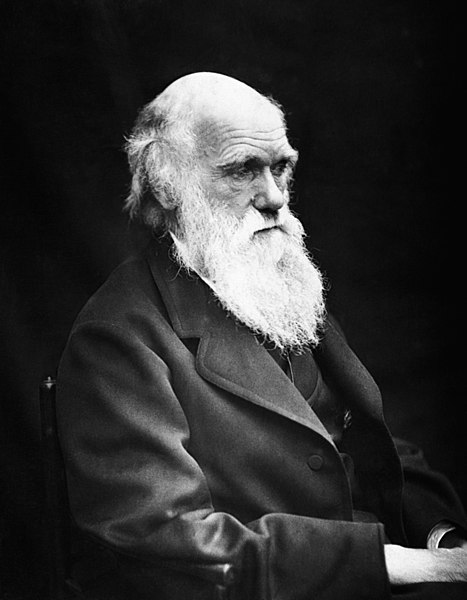
Photograph of Charles Darwin by Julia Margaret Cameron. Public domain, Wikimedia Commons.
The oldest publication that mentions Charles Darwin as the source of a similar quotation appears to be an address at a dinner meeting of the Southeastern Section of the Mathematical Association of America on March 29, 1940. The address was given by Tomlinson Fort, and it was published in the American Mathematical Monthly in November of that year. Although Fort provided citations for every other quotation used in the speech, he included no citation for his reference to Darwin—and expressed doubt that Darwin was really the source:
I have heard it said that Charles Darwin gave the following. (He probably never did.) “A mathematician is a blind man in a dark room looking for a black hat which isn’t there” [Fort 1940, p. 606].
Notice the slight difference in this quotation, with “hat” instead of “cat.”
Variations on this metaphor were apparently very popular in the 18th and early 19th centuries, making comparisons to members of the clergy, pessimists, artists, and other subjects instead of mathematicians. For example, in the book “Pie Powder”, Being Dust from the Law Courts: Collected and Recollected on the Western Circuit, by a Circuit Tramp, published in 1911, the author John Foote talked about the British judge, Charles Bowen:
Another famous example, which the present writer was fortunate enough to hear personally, was addressed to a barrister arguing a bad point in the Court of Appeal on the ground of an ‘equity’ in the case. “When I hear of an ‘equity’ in a case like this,” Bowen said with judicial gravity, “I am reminded of a blind man—in a dark room—looking for a black hat—which isn't there.” Within the last few months I have seen this misquoted in the press as a search for a ‘black cat’—a variation which I feel assured that the late Lord Justice would have strongly disapproved [Foote 1911, pp. 25–26].
Another version of the quotation, which is also commonly attributed to Charles Bowen, appears in the book Old and Odd Memories, published in 1908 by Lionel Tollemache. The author reminisced about his time in Balliol College at Oxford University, including his memories of both Charles Bowen and the Master of Balliol, Benjamin Jowett:
Bowen followed the example of Jowett in thoroughly distrusting metaphysics. Thus, Jowett dissuaded a pupil from reading T. H. Green’s Prolegomena; and Bowen defined a metaphysician as ‘a blind man groping in a dark room for a black cat which is not there’ [Tollemache 1908, p. 160].
The similarities (“metaphysician” and “mathematician”, “Bowen” and “Darwin”) make it at least reasonable to suggest that a misattribution to Darwin may be rooted in this quotation by Bowen. In any case, even if Darwin did actually make such a statement about mathematicians, it appears that it wouldn’t have been very original on his part, since he would have been simply following the vogue of the times in comparing practically everything to “a blind man in a dark room” searching for something that didn’t exist.
References
Foote, John Alderson. 1911. “Pie-Powder,” Being Dust from the Law Courts. London: John Murray.
Fort, Tomlinson. 1940. Mathematics and the Sciences. The American Mathematical Monthly 47(9): 605–612.
Tollemache, Lionel Arthur. 1908. Old and Odd Memories. London: Edward Arnold.
“Quotations in Context” is a regular column written by Michael Molinsky that has appeared in the CSHPM/SCHPM Bulletin of the Canadian Society for History and Philosophy of Mathematics since 2006 (this installment was first published in May 2010). In the modern world, quotations by mathematicians or about mathematics frequently appear in works written for a general audience, but often these quotations are provided without listing a primary source or providing any information about the surrounding context in which the quotation appeared. These columns provide interesting information on selected statements related to mathematics, but more importantly, the columns highlight the fact that students today can do the same legwork, using online databases of original sources to track down and examine quotations in their original context.
Quotations in Context: Einstein
“But there is another reason for the high repute of mathematics: it is mathematics that offers the exact natural sciences a certain measure of security which, without mathematics, they could not attain.”
“As far as the laws of mathematics refer to reality, they are not certain;
and as far as they are certain, they do not refer to reality.”
The two Albert Einstein quotations above frequently appear without citation. For example, the first quotation is printed in the “They Say, What They Say, Let Them Say” pages at the beginning of E. T. Bell’s Men of Mathematics, and the second can be found in the third volume of James R. Newman’s The World of Mathematics. The quotations, placed side-by-side, might look somewhat contradictory at first glance, since one seems to indicate that mathematics is a boon to natural science, while the other appears to say that mathematics is of no use in describing the real world; however, both of these quotations actually originate from the same source and occur only a few sentences apart.
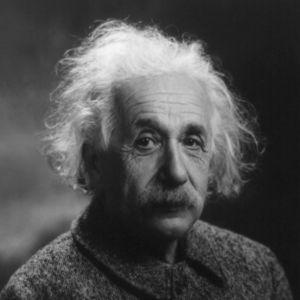
Photograph of Albert Einstein. Convergence Portrait Gallery.
On January 27, 1921, Albert Einstein presented a lecture to the Prussian Academy of Sciences entitled “Geometry and Experience.” His complete paper was printed later that year and appeared in English translation a year later. In his paper, Einstein discussed the geometric model of the universe and how to best determine what that model must be. He also considered ways to visualize non-Euclidean concepts such as sets that are finite, but unbounded. Both of the quotations above, however, appeared at the beginning of the paper, when Einstein sets out to distinguish between “axiomatic” and “practical” mathematics.
The paper began with separating mathematics from science by means of certainty: mathematical propositions are not subject to debate, whereas scientific propositions, even when supported by all current facts, may be falsified by later data. Einstein pointed out that, while the natural sciences may not be completely certain, their use of mathematics introduces at least some level of certainty to the mix. It was at this point that the first quotation appeared:
Die Mathematik genießt vor allen anderen Wissenschaften aus einem Grunde ein besonderes Ansehen; ihre Sätze sind absolut sicher und unbestreitbar, während die aller andern Wissenschaften bis zu einem gewissen Grad umstritten und stets in Gefahr sind, durch neu entdeckte Tatsachen umgestoßen zu werden. Trotzdem brauchte der auf einem anderen Gebiete Forschende den Mathematiker noch nicht zu beneiden, wenn sich seine Sätze nicht auf Gegenstände der Wirklichkeit, sondern nur auf solche unserer bloßen Einbildung bezögen. Denn es kann nicht wundernehmen, wenn man zu übereinstimmenden logischen Folgerungen kommt, nachdem man sich über die fundamentalen Sätze (Axiome) sowie über die Methoden geeinigt hat, vermittels welcher aus diesen fundamentalen Sätzen andere Sätze abgeleitet werden sollen. Aber jenes große Ansehen der Mathematik ruht andererseits darauf, daß die Mathematik es auch ist, die den exakten Naturwissenschaften ein gewisses Maß von Sicherheit gibt, das sie ohne Mathematik nicht erreichen könnten [Einstein 1921, p. 3].
One reason why mathematics enjoys special esteem, above all other sciences, is that its laws are absolutely certain and indisputable, while those of all other sciences are to some extent debatable and in constant danger of being overthrown by newly discovered facts. In spite of this, the investigator in another department of science would not need to envy the mathematician if the laws of mathematics referred to objects of our mere imagination, and not to objects of reality. For it cannot occasion surprise that different persons should arrive at the same logical conclusions when they have already agreed upon the fundamental laws (axioms), as well as the methods by which other laws are to be deduced therefrom. But there is another reason for the high repute of mathematics, in that it is mathematics which affords the exact sciences a certain measure of security, to which without mathematics they could not attain [Einstein 1922, pp. 27–28].
Einstein then asked a familiar question: why should mathematics, based on axioms and independent of experience, be so useful as a tool for modeling reality? It is in response to the idea that human beings might be able to determine the properties of the world by thought and reason alone that the second quotation appears.
An dieser Stelle nun taucht ein Rätsel auf, das Forscher aller Zeiten so viel beunruhigt hat. Wie ist es möglich, daß die Mathematik, die doch ein von aller Erfahrung unabhängiges Produkt des menschlichen Denkens ist, auf die Gegenstände der Wirklichkeit so vortrefflich paßt? Kann denn die menschliche Vernunft ohne Erfahrung durch bloßes Denken Eigenschaften der wirklichen Dinge ergründen?
Hierauf ist nach meiner Ansicht kurz zu antworten: Insofern sich die Sätze der Mathematik auf die Wirklichkeit beziehen, sind sie nicht sicher, und insofern sie sicher sind, beziehen sie sich nicht auf die Wirklichkeit [Einstein 1921, p. 3].
At this point an enigma presents itself which in all ages has agitated inquiring minds. How can it be that mathematics, being after all a product of human thought which is independent of experience, is so admirably appropriate to the objects of reality? Is human reason, then, without experience, merely by taking thought, able to fathom the properties of real things?
In my opinion the answer to this question is, briefly, this:—As far as the laws of mathematics refer to reality, they are not certain; and as far as they are certain, they do not refer to reality [Einstein 1922, p. 28].
Although the quotation itself only says “mathematics,” the following sentences make clear that, in this context, the mathematics in question is “axiomatic” mathematics. Using geometry as an example, Einstein proceeded through the familiar argument that, in its purely axiomatic form, the expressions “straight line” and “point” have no connections to real objects or properties of the real world. Any properties they have proceed from the axioms and only from the axioms.
Einstein then defined “practical geometry,” which takes axiomatic geometry and adds a proposition about how it relates to reality; for example, that solid bodies in the real world behave just like solid bodies in Euclidean Geometry. He pointed out that this proposition is not accepted as an axiom, but instead as a scientific premise, to be tested through experience and experimentation. This is clearly the intended context of the first quotation: that while science benefits from a degree of certainty through the use of “practical” mathematics, it cannot provide full certainty, because future experience may demonstrate that a proposed correspondence between a mathematical object and a property of the universe will be found to be invalid.
References
Einstein, Albert. 1921. Geometrie und Erfahrung. Berlin: Julius Springer.
Einstein, Albert. 1922. Sidelights on Relativity. Translated by G. B. Jeffery and W. Perrett. London: Methuen & Co., Ltd.
“Quotations in Context” is a regular column written by Michael Molinsky that has appeared in the CSHPM/SCHPM Bulletin of the Canadian Society for History and Philosophy of Mathematics since 2006 (this installment was first published in May 2007). In the modern world, quotations by mathematicians or about mathematics frequently appear in works written for a general audience, but often these quotations are provided without listing a primary source or providing any information about the surrounding context in which the quotation appeared. These columns provide interesting information on selected statements related to mathematics, but more importantly, the columns highlight the fact that students today can do the same legwork, using online databases of original sources to track down and examine quotations in their original context.
Quotations in Context: Fontenelle
“Mathematicians are like lovers. . . . Grant a mathematician the least principle, and he will draw from it a consequence which you must also grant him, and from this consequence another.”
I think I first encountered the above quotation by the French author Bernard Le Bovier de Fontenelle in E. T. Bell’s Men of Mathematics about thirty years ago. The origin of the quotation is Fontenelle’s most famous work, Entretiens sur la pluralité des mondes (Conversations on the Plurality of Worlds), first published in 1686 [Fontenelle 1686]. The book was intended to explain selected topics in science and astronomy to a popular audience; Fontenelle explained in the preface to the book that this was why he chose to write in French rather than Latin. The work was organized around conversations between a philosopher and a marquise that take place over the course of six consecutive evenings.

Painting of Fontenelle by Hyacinthe Rigaud, 1713. Public domain, Wikimedia Commons.
The subject quotation for this column is taken from the conversation on the fifth evening:
Ecoutez, Madame, répondis-je, puis que nous sommes en humeur de mêler toûjours des folies de galanterie à nos Discourse les plus serieux, les raisonnemens de Mathematique sont faits comme l’Amour. Vous ne sçauriez accorder si peu de chose à un Amant, que bien-tost aprés il ne faille luy en accorder davantage, & puis encore davantage, & à la fin cela va loin. De mesme accordez à un Mathematicien le moindre principe, il va vous en tirer une consequence, qu’il faudra que vous luy accordiez aussi, & de cette consequence encore une autre, & malgré vous-mesme il vous mene si loin, qu’à peine le pouvez vous croire. Ces deux sortes de Gens-là prennent toûjours plus qu’on ne leur donne [Fontenelle 1686, pp. 308–310].
Hear me, Madam, says I, since we are in the humour of mingling Amorous Follies with our most serious Discourse, I must tell you, that in Love and the Mathematicks, People reason alike: Allow never so little to a Lover, yet presently after you must grant him more; nay, more and more; which will at last go a great way. In like manner, grant but a Mathematician one little Principle, he immediately draws a Consequence from it, to which you must necessarily assent; and from this Consequence another, till he leads you so far (whether you will or no) that you have much ado to believe him. These two sorts of People, Lovers and Mathematicians, will always take more then [sic] you give ‘em [Fontenelle 1715, p. 140].
You might be surprised to learn that the context in which this quotation appears is a discussion of the likelihood of the existence of life on other planets. Here are the sentences that immediately follow the selection given above:
Vous convenez que quand deux choses sont semblables en tout ce qui me paroist, je les puis croire aussi semblables en ce qui ne me paroist point, s'il n'y a rien d'ailleurs qui m'en empesche. De là j'ay tiré que la Lune estoit habitée, parce qu'elle ressemble à la Terre, les autres Planetes, parce qu'elles ressemblent à la Lune. Je trouve que les Etoiles Fixes ressemblent à nostre Soleil, je leur attribuë tout ce qu'il a. Vous estes engagée trop avant pour pouvoir reculer, il faut franchir le pas de bonne grace [Fontenelle 1686, pp. 310–311].
You grant that when two things are like another in all visible respects, it is possible they may be like one another in those Respects that are not visible, if you have not some good reason to believe otherwise: Now this way of arguing have I made use of. The Moon, says I, is inhabited, because she is like the Earth; and the other Planets are inhabited, because they are like the Moon; I find the fix’d Stars to be like our Sun, therefore I attribute to them what is proper to that: You are now gone too far to be able to retreat, therefore you must go forward with a good Grace [Fontenelle 1715, pp. 140–141].
References
Fontenelle, Bernard de. 1686. Entretiens sur la pluralité des mondes. Paris: C. Blageart.
Fontenelle, Bernard de. 1715. Conversations on the Plurality of Worlds. Translated by William Gardiner. London: A. Bettesworth.
“Quotations in Context” is a regular column written by Michael Molinsky that has appeared in the CSHPM/SCHPM Bulletin of the Canadian Society for History and Philosophy of Mathematics since 2006 (this installment was first published in May 2015). In the modern world, quotations by mathematicians or about mathematics frequently appear in works written for a general audience, but often these quotations are provided without listing a primary source or providing any information about the surrounding context in which the quotation appeared. These columns provide interesting information on selected statements related to mathematics, but more importantly, the columns highlight the fact that students today can do the same legwork, using online databases of original sources to track down and examine quotations in their original context.
Quotations in Context: Galileo – 1
“Measure what is measurable, and make measurable what is not so.”
Variations of the quotation above have been repeatedly ascribed to Galileo Galilei over the last century, but a primary source for the quotation is never provided. An examination of some of his most famous works—The Assayer, Dialogue Concerning the Two Chief World Systems, Discourse on Two New Sciences, Letter to the Grand Duchess Christina, Mechanics, On Motion, and Sidereus Nuncius—shows that they contain no such statement; however, this is by no means a comprehensive list of his published writings, and it is always possible that the quotation appears in a private letter or set of unpublished notes.

Painting of Galileo, artist unknown but in the style of Justus Sustermans. Public domain, Wellcome Collection.
The oldest source I have been able to discover that contains the above quotation is the work Galilée: Les droits de la science et la méthode des sciences physiques, which was published by historian of science Thomas Henri Martin in 1868. In this book, Martin stated the following, with the key text shown in bold:
Galilée sait que tous les objets physiques sont étendus et par conséquent mesurables par essence, quoiqu’ils ne soient pas toujours mesurables pour nous; il sait que tous les phénomènes physiques s’accomplissent en des temps susceptibles de mesure; il sait que les phénomènes purement physiques doivent se réduire à des mouvements, les uns perceptibles pour nos sens, les autres imperceptibles pour nous à titre de mouvements appréciables. Il déclare que dans tous ces phénomènes il faut mesurer tout ce qui est mesurable, et tâcher de rendre mesurable tout ce qui ne l’est pas directement. Il ne s’agit donc pas de poser des principes, les uns métaphysiques, les autres mathématiques, puis d’essayer d’en conclure a priori quelles doivent être les lois physiques; mais il s’agit d’abord d’observer, d’expérimenter, de mesurer, de compter, et ensuite de demander aux mathématiques et au raisonnement la formule, l’analyse, la transformation et le développement des résultats obtenus [Martin 1868, p. 289].
Although Martin’s work contained direct quotations from Galileo, he did not denote this specific passage as being one. This suggests that this famous “quotation” might not represent a direct statement from Galileo, but that it is instead a summary description of his ideas and beliefs written by a much later author.
Reference
Martin, Thomas Henri. 1868. Galilée: Les droits de la science et la méthode des sciences physiques. Paris: Didier et cie.
“Quotations in Context” is a regular column written by Michael Molinsky that has appeared in the CSHPM/SCHPM Bulletin of the Canadian Society for History and Philosophy of Mathematics since 2006 (this installment was first published in May 2013). In the modern world, quotations by mathematicians or about mathematics frequently appear in works written for a general audience, but often these quotations are provided without listing a primary source or providing any information about the surrounding context in which the quotation appeared. These columns provide interesting information on selected statements related to mathematics, but more importantly, the columns highlight the fact that students today can do the same legwork, using online databases of original sources to track down and examine quotations in their original context.
Quotations in Context: Galileo – 2
“Mathematics is the language with which God has written the universe.”
Unlike the previous column, in which I argued a quotation may be misattributed to Galileo Galilei, the sentence above unquestionably does have its original source in his works. However, even considering the changes necessary when translating from Italian to English, it would be more accurate to describe it as a paraphrase rather than as an actual quotation of Galileo. The “quotation" has appeared (with slightly varied wordings) in numerous publications over the last fifty years, and the oldest example I’ve found is at the conclusion of the 1959 classic Disney short animated film Donald in Mathmagic Land, where it is stated as “Mathematics is the alphabet with which God has written the universe” [Clark 1959].
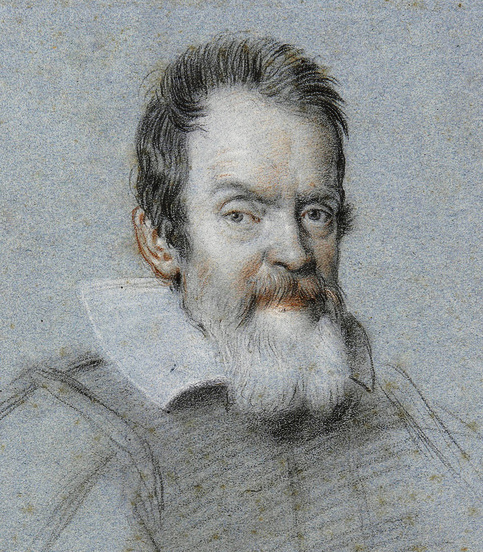
Drawing of Galileo by Ottavio Leoni, 1624. Public domain, Wikimedia Commons.
The original source material is from Galileo’s Il Saggiatore (The Assayer), published in 1623, which was written in response to the work Libra astronomica ac philosophica, published in 1619 by the Jesuit scholar Orazio Grassi under the pseudonym “Lothario Sarsio Sigensano.” Galileo addressed his remarks directly to “Sarsi," even though he stated early in Il Saggiatore that he knew full well that this was not the author’s true name. The material related to the subject of this column appeared when Galileo attacked the author’s adherence to the theories and work of Tycho Brahe.
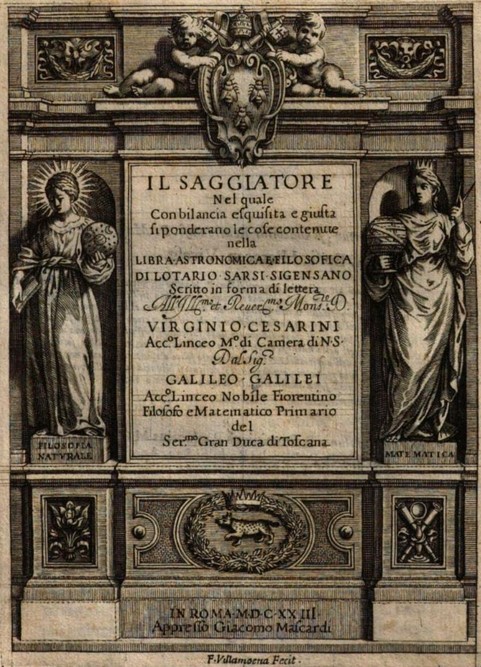
Title page of Il Saggiatore, 1623. Public domain, Google Books.
Below is the original Italian text from Il Saggiatore, followed by an English translation of the passage from Discoveries and Opinions of Galileo by Stillman Drake, published in 1957:
Parmi oltre à ciò di scorgere nel Sarsi ferma credenza, che nel filosofare sia necessario appoggiarsi all’opinioni di qualche celbre Autore, si che la mente nostra, quando non si maritasse col discorso d’vn’altro, ne dovesse in tutto rimanere sterile, ed infeconda; e sorse stima, che la Filosofia sia un libro, e une fantasia d’un uomo, come l’Iliade, e l’Orlando furioso, libri ne quali la meno importante cosa è, che quello che vi è scritto, sia vero. S. Sarsi la cosa non istà così. La Filosofia è scritta in questo grandissimo libro, che continuamente ci stà aperto innanzi à gli occhi (io dico l’universo) ma non si può intendere se prima non s’impara à intender la lingua, e conoscere i caratteri nei quali è scritto. Egli è scritto in lingua matematica, e i caratteri son triangoli, cerchi, & altre figure Geometriche, senza i quali mezi è impossibile à intenderne umanamente parola; senza questi è un aggirarsi vanamente per un’oscuro laberinto [Galileo 1623, pp. 24–25].
In Sarsi I seem to discern the firm belief that in philosophizing one must support oneself upon the opinion of some celebrated author, as if our minds ought to remain completely sterile and barren unless wedded to the reasoning of some other person. Possibly he thinks that philosophy is a book of fiction by some writer, like the Iliad or Orlando Furioso, productions in which the least important thing is whether what is written there is true. Well, Sarsi, that is not how matters stand. Philosophy is written in this grand book, the universe, which stands continually open to our gaze. But the book cannot be understood unless one first learns to comprehend the language and read the letters in which it is composed. It is written in the language of mathematics, and its characters are triangles, circles, and other geometric figures without which it is humanly impossible to understand a single word of it; without these, one wanders about in a dark labyrinth [Galileo 1957, pp. 237–238].
References
Clark, Les, Hamilton Luske, Joshua Meador and Wolfgang Reitherman, directors. 1959. Donald in Mathmagic Land. Walt Disney Animation Studios.
Galileo. 1623. Il Saggiatore. Rome: Giacomo Mascardi.
Galileo. 1957. Discoveries and Opinions of Galileo. Translated by Stillman Drake. New York: Doubleday Anchor Books.
“Quotations in Context” is a regular column written by Michael Molinsky that has appeared in the CSHPM/SCHPM Bulletin of the Canadian Society for History and Philosophy of Mathematics since 2006 (this installment was first published in May 2014). In the modern world, quotations by mathematicians or about mathematics frequently appear in works written for a general audience, but often these quotations are provided without listing a primary source or providing any information about the surrounding context in which the quotation appeared. These columns provide interesting information on selected statements related to mathematics, but more importantly, the columns highlight the fact that students today can do the same legwork, using online databases of original sources to track down and examine quotations in their original context.
Quotations in Context: Holmes
“Descartes commanded the future from his study
more than Napoleon from the throne.”
The statement above is often misattributed to American physician and author Oliver Wendell Holmes (1809–1894). It can instead be traced to the writings of his son, Oliver Wendell Holmes, Jr. (1841–1935), from a book published several years before the son’s appointment to the United States Supreme Court.
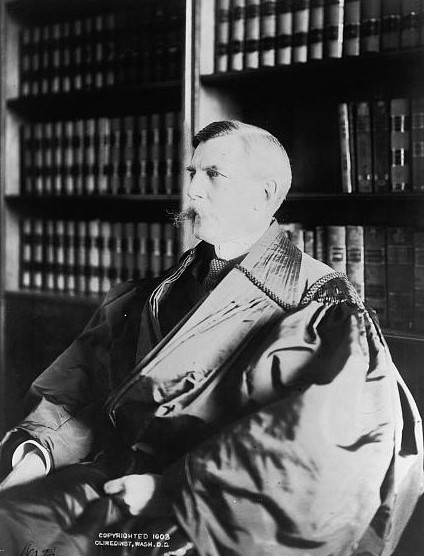
Photograph of Oliver Wendell Holmes, Jr., ca 1903. Public domain, Library of Congress.
In 1900, a revised English edition of Montesquieu’s The Spirit of the Laws was reprinted by the D. Appleton and Company publishing house in New York. This edition contained an introduction written by Oliver Wendell Holmes, Jr., who at that time was Chief Justice of the Massachusetts Supreme Judicial Court.
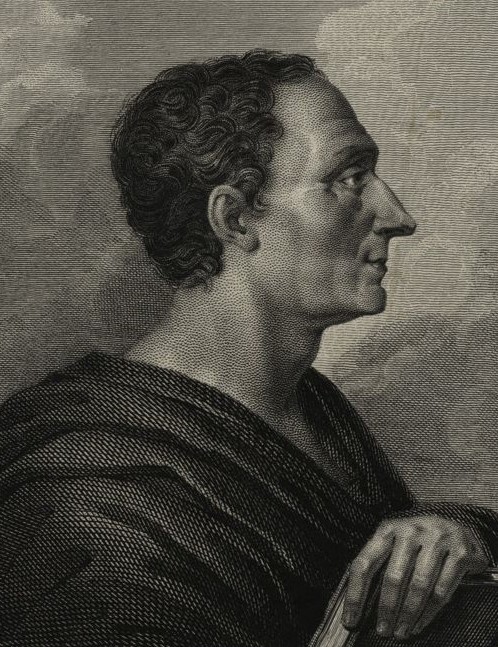
Engraving of Montesquieu. Public domain, New York Public Library.
The introduction began on a rather odd note by appearing to dismiss the importance and relevance of The Spirit of the Laws:
But the greatest works of intellect soon lose all but their historical significance. The science of one generation is refuted or outgeneralized by the science of the next; the philosophy of one century is taken up or transcended by the philosophy of a later one. . . . Montesquieu was a man of science and at the same time a man of the world. As a man of science he wrote an epoch-making book. And just because and in so far as his book was a work of science and epoch-making, it is as dead as the classics [Montesquieu 1900, pp. iii–iv].
Holmes did emphasize that The Spirit of the Laws contains enough wit to make it “fresh and pleasant reading” [Montesquieu 1900, p. iv] and that “one might read that work happily enough simply as literature” [Montesquieu 1900, p. v]. But to be truly appreciated as a work of genius, Holmes argued that the writings of Montesquieu should be read not by the young for instruction, but rather as “one of the last achievements of a studious life” [Montesquieu 1900, p. v].
After a short biography of Montesquieu, the introduction stated, “It would be out of place to offer an analysis of a book which is before the reader” [Montesquieu 1900, p. xiii], which was immediately followed by an analysis of the book before the reader. Montesquieu’s depiction of Rome was described as “fable uncritically accepted,” his “anthropology was anecdotic,” and his analysis of separation of powers in England as “a fiction invented by him” [Montesquieu 1900, p. xiii]. Having roundly condemned the actual content of the work, Holmes returned to praise by emphasizing the book’s importance to what came after it:
There is not space even to point out how many seeds it sowed. Montesquieu is a precursor, to repeat the word, in so many ways…His book had a dazzling success at the moment, and since then probably has done as much to remodel the world as any product of the eighteenth century, which burned so many forests and sowed so many fields [Montesquieu 1900, p. xiv].
It was at this point in the introduction that the subject of this column finally appears, although the actual quotation in the text is only peripherally about the mathematician René Descartes:
And this was the work of a lonely scholar sitting in a library. Like Descartes or Kant, he commanded the future from his study more than Napoleon from his throne [Montesquieu 1900, p. xiv].
It is not clear when or by whom Kant and Montesquieu were first excised, but the revised version that only mentions Descartes has proved extremely popular in collections of mathematical quotations. It is only in works focusing on the writings and career of Justice Holmes that the complete and accurate quotation still appears.
References
Montesquieu, Charles Louis de Secondat and Oliver Wendell Holmes, Jr. 1900. The Spirit of the Laws. Translated by Thomas Nugent. Edited by J. V. Prichard. Vol. 1. New York: D. Appleton and Company.
“Quotations in Context” is a regular column written by Michael Molinsky that has appeared in the CSHPM/SCHPM Bulletin of the Canadian Society for History and Philosophy of Mathematics since 2006 (this installment was first published in November 2010). In the modern world, quotations by mathematicians or about mathematics frequently appear in works written for a general audience, but often these quotations are provided without listing a primary source or providing any information about the surrounding context in which the quotation appeared. These columns provide interesting information on selected statements related to mathematics, but more importantly, the columns highlight the fact that students today can do the same legwork, using online databases of original sources to track down and examine quotations in their original context.
Quotations in Context: Jacobi
“Man muss immer generalisieren.” [One must always generalize.]
“Man muss immer umkehren.” [One must always invert.]
The above quotations frequently appear in modern publications, both in works of mathematics as well as in other subject areas; for example, the second quotation seems to be particularly popular in the field of finance. While all of these modern sources attribute both sentences to the nineteenth century mathematician Carl Jacobi, none of them provide a primary source or any original context for the quotations.
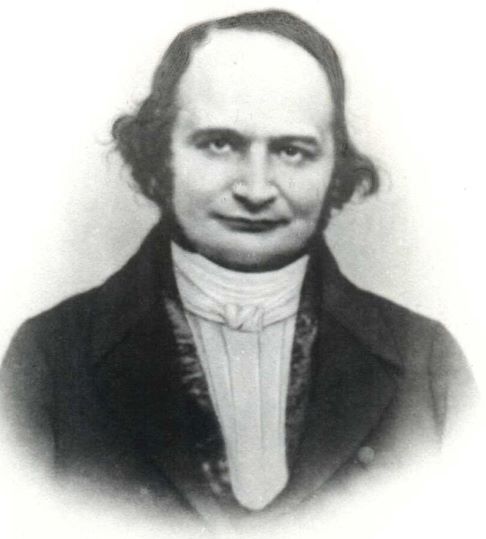
Photograph of Jacobi. Convergence Portrait Gallery.
The oldest work that I’ve managed to locate that contains either of these quotations is “Current Tendencies of Mathematical Research” by Edward B. Van Vleck, which appeared in the October 1916 issue of the Bulletin of the American Mathematical Society. Professor Van Vleck was a faculty member at the University of Wisconsin-Madison and a past AMS president (1913–1914), and this paper contains an address he presented during the University of Chicago’s Quarter-Centennial celebration.
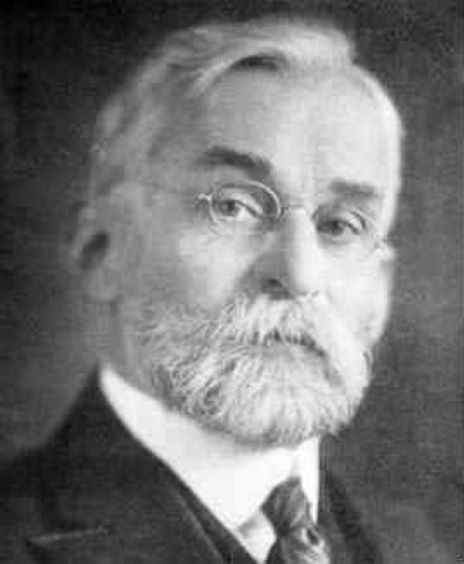
Photograph of Van Vleck. Convergence Portrait Gallery.
The paper began by exploring examples of how specific problems provided influence and direction to the development of mathematics during various historical periods, which led Van Vleck to ask the question, “What are the central problems in the mathematical research of to-day?” [Van Vleck 1916, p. 2]. He offered the topic of infinite sets as one possible answer to the question. It was at this point in the paper that the second quotation of this column appears:
The characteristic tendency in the thought of to-day which I have tried to grasp under the comprehensive term “Problem of the infinite set” is shown rather as a current beneath the surface than in any individual concrete problem. The average investigator must perforce seize upon any problem which his brains find at hand. There exist, however, certain fundamental principles which will aid him in finding a worthy one. The great mathematician Jacobi is said to have inculcated upon his students the dictum: Man muss immer umkehren. One must always seek a converse, turn a thought the other end to. It was by turning the elliptic integral inside out that Jacobi obtained his splendid theory of elliptic and theta functions [Van Vleck 1916, p. 3].
In the very next paragraph of the paper, the first quotation of this column appeared; however, in this case Van Vleck did not attribute it to Jacobi, but instead claimed it as his own invention:
Without dwelling further upon the fertility of Jacobi’s dictum, I wish to coin and put beside it another obvious dictum of yet wider reach: Man muss immer generalizieren [Van Vleck 1916, p. 3].
Later in the paper, Van Vleck repeated both quotations and again distinctly gave Jacobi credit for “Man muss immer umkehren,” but not for “Man muss immer generalizieren.” While it is possible that Jacobi used both phrases without Van Vleck being aware of it, the contents of this paper and the lack of any apparent earlier sources both suggest that Van Vleck is the true, original source of the “generalize” version of the quotation.
As for “Man muss immer umkehren,” while Van Vleck did attribute it to Jacobi, he provided no details on his source for the quotation; further, since he only claimed that Jacobi “is said to have” made such a statement, it seems clear that Van Vleck didn’t derive the quote directly from any of Jacobi’s works. While I haven’t been able to examine every single book, paper, or letter written by Jacobi, my inability to find any source prior to 1916 that contains even a passing reference to this quotation raises the possibility that it also may be misattributed and not truly originate with Jacobi.
Reference
Van Vleck, Edward B. 1916, October. “Current Tendencies of Mathematical Research.” Bulletin of the American Mathematical Society 23(1): 1–13.
“Quotations in Context” is a regular column written by Michael Molinsky that has appeared in the CSHPM/SCHPM Bulletin of the Canadian Society for History and Philosophy of Mathematics since 2006 (this installment was first published in November 2016). In the modern world, quotations by mathematicians or about mathematics frequently appear in works written for a general audience, but often these quotations are provided without listing a primary source or providing any information about the surrounding context in which the quotation appeared. These columns provide interesting information on selected statements related to mathematics, but more importantly, the columns highlight the fact that students today can do the same legwork, using online databases of original sources to track down and examine quotations in their original context.
Quotations in Context: Napoleon
The advancement and perfection of mathematics
are intimately connected with the prosperity of the State.
The story of Pierre-Simon Laplace’s presentation of his work Mécanique céleste to Napoleon is well known. According to Augustus De Morgan in A Budget of Paradoxes (first published in London in 1872):
Napoleon, whom some wags had told that this book contained no mention of the name of God, and who was fond of putting embarrassing questions, received it with—‘M. Laplace, they tell me you have written this large book on the system of the universe, and have never even mentioned its Creator.’ Laplace, who, though the most supple of politicians, was as stiff as a martyr on every point of his philosophy or religion (ex. gr. even under Charles X. he never concealed his dislike of the priests), drew himself up, and answered bluntly, `Je n’avais pas besoin de cette hypothèse-là’ [I did not need that hypothesis]. Napoleon, greatly amused, told this reply to Lagrange, who exclaimed, ‘Ah! c’est une belle hypothèse; ça explique beaucoup de choses’ [Ah! It is a beautiful hypothesis; that explains a lot; De Morgan 1872, pp. 249–250].
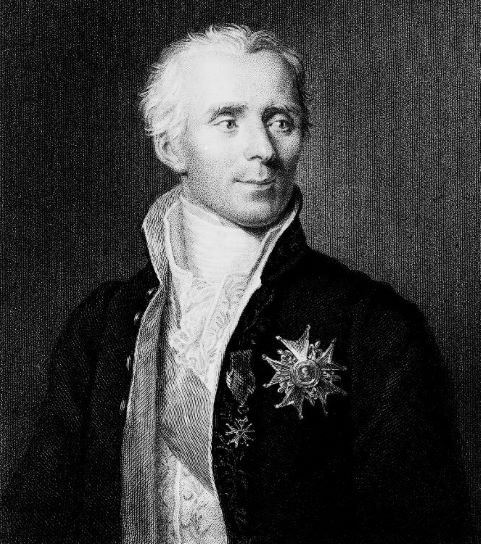
Stipple engraving of Laplace by James Posselwhite after Jacques-André Naigeon.
Public domain, Wellcome Collection.
Several years later, in 1812, Laplace also presented Napoleon with a copy of his work Théorie analytique des probabilitiés, although this time he did not do so in person. In the summer of 1812, Napoleon had begun his ill-fated invasion of Russia, and by the end of July he had captured the city of Vitebsk (which is located today in the northeastern corner of Belarus, near the Russian border). It was from this city on August 1 that Napoleon sent a brief letter to Laplace acknowledging the receipt of his work.
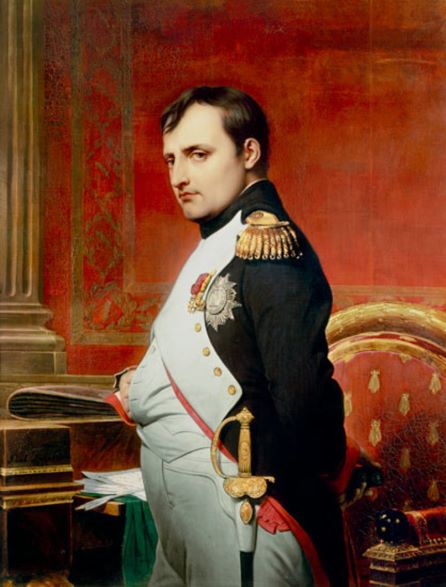
Painting of Napoleon by artist Paul Delaroche, 1838.
Public domain, Wikimedia Commons.
Napoleon began the letter by admitting that (not surprisingly under the circumstances) he didn’t have the time to read the work at present; however, he praised Laplace for both this and his other works that had helped to develop and extend knowledge of mathematics, the “first of sciences.” The letter concluded with the subject quotation of this column.
The full text of the letter, which is shown below, appears in volume 24 of Correspondance de Napoléon [Napoleon 1868, p. 131]:
AU COMTE LAPLACE
CHANCELIER DU SÉNAT ET MEMBRE DE L’INSTITUT, A PARIS
Vitebsk, 1er août 1812
Monsieur le Compte Laplace, je reçois avec plaisir votre traité du calcul des probabilities. Il est un temps où je l’aurais lu avec intérêt; aujourd’hui je dois me borner à vous témoigner la satisfaction que j’éprouve toutes les fois que je vous vois donner de nouveaux ouvrages qui perfectionnent et étendent cette première des sciences. Ils contribuent à l’illustration de la nation. L’avancement et la perfection des mathématiques sont intimement lies à la prospérité de l’État.
Napoléon
References
De Morgan, Augustus. 1872. A Budget of Paradoxes. London: Longmans, Green and Co.
Napoleon. 1868. Correspondance de Napoléon Ier. Vol. 24. Paris: Imprimerie Impériale.
“Quotations in Context” is a regular column written by Michael Molinsky that has appeared in the CSHPM/SCHPM Bulletin of the Canadian Society for History and Philosophy of Mathematics since 2006 (this installment was first published in November 2011). In the modern world, quotations by mathematicians or about mathematics frequently appear in works written for a general audience, but often these quotations are provided without listing a primary source or providing any information about the surrounding context in which the quotation appeared. These columns provide interesting information on selected statements related to mathematics, but more importantly, the columns highlight the fact that students today can do the same legwork, using online databases of original sources to track down and examine quotations in their original context.
Quotations in Context: Oppenheimer
Today, it is not only that our kings do not know mathematics, but our philosophers do not know mathematics and—to go a step further—
our mathematicians do not know mathematics.
In April 1958, the theoretical physicist J. Robert Oppenheimer presented a talk to the International Press Institute in Washington, D.C.; six months later, the full text of the speech was published in an article in Harper’s Magazine, “The Tree of Knowledge.” In this article, Oppenheimer talked about the nature of scientific knowledge and the way it had changed over the centuries:
There are enormous differences between our world of learning today—our Tree of Knowledge—and those of Athens, or the Enlightenment, or the dawn of science in fifteenth- and sixteenth-century Europe [Oppenheimer 1958, p. 55].
Oppenheimer discussed the growing number of scientists and the spread of scientific knowledge, the relationships and differences between “pure” and “practical” science, and the consequences of scientific progress. He concluded the speech by arguing that the continuing growth of science would inevitably pose difficulties in achieving the goal of nuclear disarmament.

Photograph of Oppenheimer, ca 1944.
Public domain, U.S. National Archives and Records Administration.
It was only in the introduction of the speech that Oppenheimer talked specifically about mathematics. In order to show how much knowledge had changed over the centuries, Oppenheimer offered an example from ancient Greece:
You can get some suggestion of how shattering these changes have been if you remember that Plato, when he tried to think about human salvation and government, recommended mathematics as one of the ways to learn to know the truth, to discriminate good from evil and the wise from the foolish. Plato was not a creative mathematician, but students confirm that he knew the mathematics of his day, and understood it, and derived much from it [Oppenheimer 1958, p. 55].
It was at this point that the subject quotation of this column appears. When shown out of context, the quotation could be taken to mean that today’s mathematicians do not know any mathematics; however, Oppenheimer only argued that, in contrast to Plato’s day, it was no longer possible for any one person to comprehend all of mathematics:
Today, it is not only that our kings do not know mathematics, but our philosophers do not know mathematics and—to go a step further—our mathematicians do not know mathematics. Each of them knows a branch of the subject and they listen to each other with a fraternal and honest respect; and here and there you find a knitting together of the different fields of mathematical specialization [Oppenheimer 1958, p. 55].
While Plato’s Republic may have argued that an ideal ruler should be well versed in mathematical knowledge, Oppenheimer concluded the introduction to his speech by stating that, while the continued study of mathematics was undeniably well and flourishing, “it is not likely today that our most learned advisers—the men who write in the press and tell us what we may think—would suggest that the next President of the United States be able to understand the mathematics of the day” [Oppenheimer 1958, p. 55].
References
Oppenheimer, J. Robert. 1958, October. “The Tree of Knowledge.” Harper’s Magazine 217(1301): 55–60.
“Quotations in Context” is a regular column written by Michael Molinsky that has appeared in the CSHPM/SCHPM Bulletin of the Canadian Society for History and Philosophy of Mathematics since 2006 (this installment was first published in May 2012). In the modern world, quotations by mathematicians or about mathematics frequently appear in works written for a general audience, but often these quotations are provided without listing a primary source or providing any information about the surrounding context in which the quotation appeared. These columns provide interesting information on selected statements related to mathematics, but more importantly, the columns highlight the fact that students today can do the same legwork, using online databases of original sources to track down and examine quotations in their original context.
Quotations in Context: Plato – 1
“I have hardly ever known a mathematician who was capable of reasoning.”
In 1888, Benjamin Jowett (1817–1893), the master of Balliol College, Oxford, published the third edition of his English translation of Plato’s Republic. This edition is the source of the quotation above. The quotation certainly appears to claim that mathematicians are incapable of any kind of reasoning. Paul Shorey (1857–1934), a Greek scholar at the University of Chicago, referred to this line as “Jowett’s wicked jest” [Plato 1969, p. 531]. When the quotation is placed within the context of Plato’s arguments in the sixth and seventh books of the Republic, it is clear that Plato’s intended meaning was very different.

Photograph of Benjamin Jowett. Public domain, from the book Oxford Men
& Their Colleges (Oxford, 1893), as digitized by the Internet Archive.
In the sixth book, Plato argued that the world can be divided into the visible and the intellectual. In the dialogue, Socrates tells Glaucon that the intellectual world can be broken further into two categories:
There are two subdivisions, in the lower of which the soul uses the figures given by the former division as images; the enquiry can only be hypothetical, and instead of going upwards to a principle descends to the other end; in the higher of the two, the soul passes out of hypotheses, and goes up to a principle which is above hypotheses, making no use of images as in the former case, but proceeding only in and through the ideas themselves [Plato 1888, p. 211].
The “lower” subdivision of the intellectual world uses hypotheses to engage in deductive reasoning. This subdivision is specifically identified with arithmetic, geometry and other mathematical sciences, which make use of the visible world as models for understanding the invisible world of thoughts and ideas. This is separated from the dialectic, the sphere of the intellect that uses tools such as discussion and debate to delve into the realm of ideas without making any use of the world of the visible.
The seventh book of the Republic explored the best way to train minds to understand the visible and the intellectual. For the subdivision of the intellectual that is concerned with deductive reasoning, the appropriate training is rigorous preparation in arithmetic, plane and solid geometry, astronomy and harmonics (i.e., the quadrivium). But Plato suggested that this training is not enough to fully prepare a student, and the quotation that is the topic of this column appears in Glaucon’s reply to Socrates:
Do you not know that all this is but the prelude to the actual strain which we have to learn? For you surely would not regard the skilled mathematician as a dialectician?
Assuredly not, he said; I have hardly ever known a mathematician who was capable of reasoning [Plato 1888, p. 235].
Glaucon’s statement, in the context of the surrounding material, clearly was not intended to mean that mathematicians are incapable of all kinds of reasoning; instead, the implication was that expertise in deductive reasoning does not necessarily translate into mastery of the form of reasoning identified as dialectic.
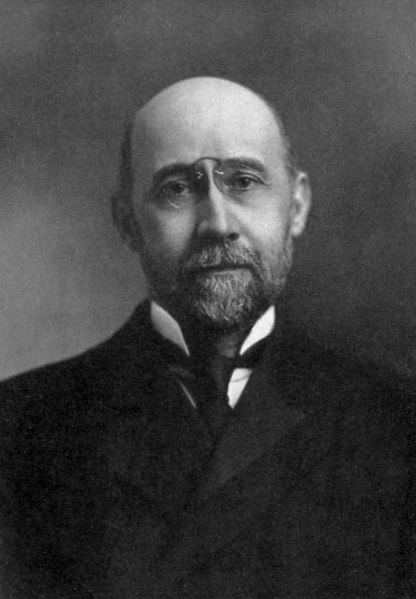
Photograph of Paul Shorey. Public domain, from the article “The Spirit of the University of Chicago”
in The University of Chicago Magazine 1, no. 6 (April 1909): 228, as reproduced in Wikimedia Commons.
Other translators seem to have avoided Jowett’s witty but potentially misleading phrasing. For example, in Shorey’s translation of the Republic (first published in two volumes in 1930 and 1935), the same text is translated into English as:
Or do we not know that all this is but the preamble of the law itself, the prelude of the strain that we have to apprehend? For you surely do not suppose that experts in these matters are reasoners and dialecticians?
No, by Zeus,” he said, “except a very few whom I have met [Plato 1969, p. 531].
Even Jowett himself gave a clearer translation of the original Greek in his first edition of the Republic, back in 1871:
Are we not advised that this is but the prelude of the actual strain which we have to learn? For I imagine that you would not regard the skilled mathematician as a dialectician?
No indeed, he said; very few mathematicians whom I have ever known are reasoners in that sense [Plato 1871, p. 359].
References
Plato. 1871. The Dialogues of Plato. Translated by Benjamin Jowett. Vol. 2. New York: Charles Scribner and Company.
Plato. 1888. The Republic of Plato. Translated by Benjamin Jowett. Oxford: Clarendon Press.
Plato. 1969. Plato in Twelve Volumes. Translated by Paul Shorey. 2nd ed. Vols 5–6. Cambridge: Harvard University Press.
“Quotations in Context” is a regular column written by Michael Molinsky that has appeared in the CSHPM/SCHPM Bulletin of the Canadian Society for History and Philosophy of Mathematics since 2006 (this installment was first published in November 2006). In the modern world, quotations by mathematicians or about mathematics frequently appear in works written for a general audience, but often these quotations are provided without listing a primary source or providing any information about the surrounding context in which the quotation appeared. These columns provide interesting information on selected statements related to mathematics, but more importantly, the columns highlight the fact that students today can do the same legwork, using online databases of original sources to track down and examine quotations in their original context.
Quotations in Context: Plato – 2
“Mathematics is like checkers in being suitable for the young, not too difficult, harmless, amusing and without peril to the state.”
For quite some time, I had been unsuccessfully trying to track down the original source of this quotation, which is attributed to Plato in many modern publications. So I was surprised and relieved to find the correct citation in the online archives for the Canadian Society for History and Philosophy of Mathematics, on the last page of the September 1988 CSHPM/SCHPM Bulletin, which contained a column of “Citations/Quotes.” No author of the column is listed, so the material may have been collected by that issue’s editor, Roger Herz-Fischler; in any case, I was very grateful to finally discover the correct source and wanted to give full credit to the Society’s archived Bulletin for showing me the way.
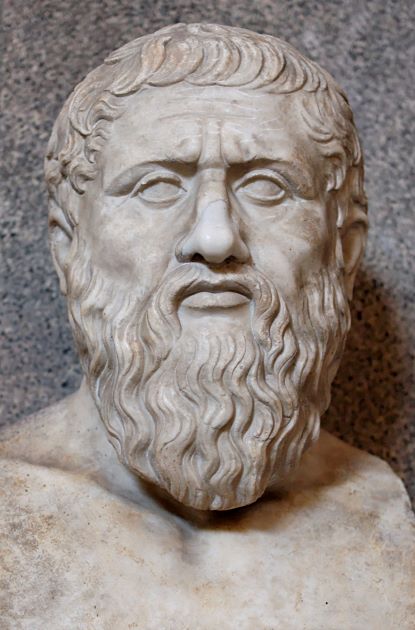
Bust representing Plato, Roman copy of earlier Greek sculpture, 4th-century BCE. Public domain, Wikimedia Commons.
In 1951, the article “A Mathematical Reappraisal of the Corpus Platonicum” appeared in the journal Scripta Mathematica. The author, Domhnall A. Steele, began the article by expressing deep concern over the “danger of trivialization” [Steele 1951, p. 173], specifically the tendency to reduce or oversimplify the works of Greek mathematicians, robbing their work of important context and translating them into something “trite and obvious” [Steele 1951, p. 173]. The author stated that this is particularly a problem with modern assessments of Plato, and he provided several examples of mathematical terms and phrases from Plato’s work, arguing that the original context supports a more meaningful and robust English translation than is usually given.
Steele argued that correct interpretation of Plato requires that we “know into what kind of mathematical world he was born” [Steele 1951, p. 176], and he explored examples of mathematics from Hippocrates, Eudoxus and Euclid to illustrate the kinds of mathematics that Plato would have seen and the level of understanding and expertise of his culture. Steele followed this with fifteen brief examples of mathematics from Plato’s own works.
The final portion of the article presented Plato’s overall views on mathematics by synthesizing statements on the subject from his many works. While this section of the article provides numerous endnotes to meticulously indicate the sources from which the views originated, this material was paraphrased rather than directly quoted, and Steele stated clearly that he would “speak for a while in Plato’s name” [Steele 1951, p. 184]. It was in this section of the article that we find this column’s quotation:
Mathematics is like checkers in being suitable for the young, not too difficult, harmless, amusing, and without peril to the state. The citizens of the ideal state, our Callipolitans, cannot be allowed to neglect mathematics, for there is an immense chasm between a man who has grasped it and a man who has not. The holders of high office must proceed to its advanced stages and master at least the theory of the multiplicative composition of numbers.
When we look to the future activity of the young in industry or affairs public or private, no subject is more suitable for their training than the science of number, for it wakes up the intellectually somniferous and confers even upon them an adroitness in excess of their natural capacity. The born arithmeticians turn out sharpwitted in other studies as well [Steele 1951, p. 185].
The endnotes in the article indicated that the sentence containing this column’s quotation was based on material from Plato’s Laws. For the sake of comparison, below is an English translation of the relevant section of Laws by Benjamin Jowett:
Athenian: The natures of commensurable and incommensurable quantities in their relation to one another. A man who is good for anything ought to be able, when he thinks, to distinguish them; and different persons should compete with one another in asking questions, which will be a far better and more graceful way of passing their time than the old man’s game of draughts.
Cleinias: I dare say; and these pastimes are not so very unlike a game of draughts.
Athenian: And these, as I maintain, Cleinias, are the studies which our youth ought to learn, for they are innocent and not difficult; the learning of them will be an amusement, and they will benefit the state. If anyone is of another mind, let him say what he has to say [Plato 1892, pp. 203–204].
I suspect that Steele’s paraphrase of Plato has proven popular in modern works because it seems to give a negative (or at least not very positive) impression of mathematics; after all, calling something “harmless” and “without peril to the state” is not usually a way of indicating that a subject is highly valued or useful. However, when the quotation is viewed in the surrounding context of Steele’s article (and also considering the original text of Plato on which it was based), it is clear how much higher of a value is really being assigned to mathematics.
References
Plato. 1892. The Dialogues of Plato. Translated by Benjamin Jowett. 3rd ed. Vol. 5. Oxford: Clarendon Press.
Steele, Domhnall A. 1951. “A Mathematical Reappraisal of the Corpus Platonicum.” Scripta Mathematica 17: 173–189.
“Quotations in Context” is a regular column written by Michael Molinsky that has appeared in the CSHPM/SCHPM Bulletin of the Canadian Society for History and Philosophy of Mathematics since 2006 (this installment was first published in May 2017). In the modern world, quotations by mathematicians or about mathematics frequently appear in works written for a general audience, but often these quotations are provided without listing a primary source or providing any information about the surrounding context in which the quotation appeared. These columns provide interesting information on selected statements related to mathematics, but more importantly, the columns highlight the fact that students today can do the same legwork, using online databases of original sources to track down and examine quotations in their original context.
Quotations in Context: Poincare
“Mathematics is the art of giving the same name to different things.”
In 1908, the Fourth International Congress of Mathematicians was held in Rome. During the Congress, the mathematician Jean-Gaston Darboux presented an address written by Henri Poincaré entitled “L’avenir des mathématiques,” and Poincaré included the paper as a chapter in his book Science et Méthode. An authorized English translation by George Bruce Halsted appeared as the chapter “The Future of Mathematics” in The Foundations of Science, first published in 1913.
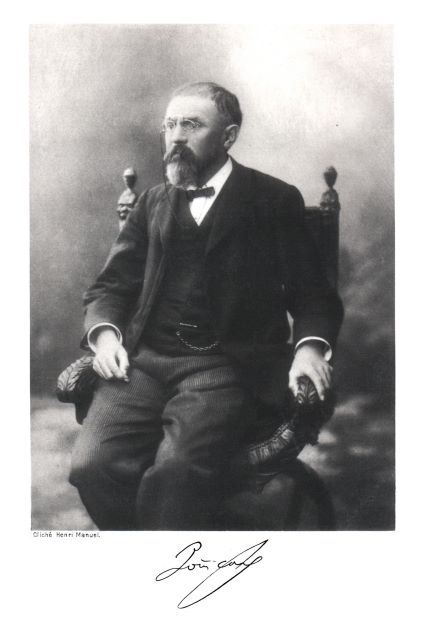
Photograph of Poincaré by Henri Manuel. Public domain, Smithsonian Libraries.
The chapter began by stating the importance of studying the history of mathematics: “To foresee the future of mathematics, the true method is to study its history and its present state” [Poincaré 1913, p. 369]. Poincaré briefly described the historical evolution of the meaning of solutions in mathematics, showing that each time it appeared every possible problem had been solved, a change in accepted solution methods (such as the shift from ruler and compass constructions to extraction of roots) would open the way for new and wider exploration.
Poincaré spent some time exploring the underlying motivation and necessity for the study of mathematics. In particular, he emphasized that despite its utility to physics and other sciences, the ultimate motivation for the study of mathematics and the identification of new problems to pursue must come from within the subject itself:
Dira-t-on que, nous autres géomètres, nous devons nous borner à attendre les commandes, et, au lieu de cultiver notre science pour notre plaisir, n'avoir d'autre souci que de nous accommoder au goût de la clientèle? Si les mathématiques n'ont d'autre objet que de venir en aide à ceux qui étudient la nature, c'est de ces derniers que nous devons attendre le mot d'ordre. Cette façon de voir est-elle légitime? Certainement non; si nous n'avions pas cultivé les sciences exactes pour elles-mêmes, nous n'aurions pas créé l'instrument mathématique, et le jour où serait venu le mot d'ordre du physicien, nous aurions été désarmés [Poincaré 1909, p. 21].
Shall it be said that we geometers should limit ourselves to awaiting orders and, in place of cultivating our science for our own delectation, try only to accommodate ourselves to the wants of our patrons? If mathematics has no other object besides aiding those who study nature, it is from these that we should await orders. Is this way of looking at it legitimate? Certainly not; if we had not cultivated the exact sciences for themselves, we should not have created mathematics the instrument, and the day the call came from the physicist we should have been helpless [Poincaré 1913, p. 370].
Citing Ernst Mach’s characterization of science as producing “economy of thought” [Poincaré 1913, p. 371], Poincaré pursued the same idea in mathematics. He emphasized the importance of finding common ideas and properties, and he noted how the labeling of those properties with a word or brief phrase allows arguments and explanations to be condensed without losing rigor or clarity. He even stated that the proper measurement of the importance of a discovery in mathematics is “the amount of thought it permits us to spare” [Poincaré 1913, p. 371].
Poincaré offered a specific example in the short phrase “uniformity of convergence,” explaining how these few simple words, when properly understood, immediately evoke (and therefore abolish the need to present) the complete and rigorous mathematical definition. It was at this point that the subject quotation of this column appeared:
Nous venons de voir par un exemple quelle est l'importance des mots en mathématiques, mais j'en pourrais citer beaucoup d'autres. On ne saurait croire combien un mot bien choisi peut économiser de pensée, comme disait Mach. Je ne sais si je n'ai pas déjà dit quelque part que la mathématique est l'art de donner le même nom à des choses différentes. Il convient que ces choses, différentes par la matière, soient semblables par la forme, qu'elles puissent pour ainsi dire se couler dans le même moule. Quand le langage a été bien choisi, on est tout étonné de voir que toutes les démonstrations, faites pour un objet connu, s'appliquent immédiatement à beaucoup d'objets nouveaux; on n'a rien à y changer, pas même les mots, puisque les noms sont devenus les mêmes [Poincaré 1909, p. 29].
We have just seen by one example the importance of words in mathematics, but many others could be cited. It is hard to believe how much a well-chosen word can economize thought, as Mach says. Perhaps I have already said somewhere that mathematics is the art of giving the same name to different things. It is proper that these things, differing in matter, be alike in form, that they may, so to speak, run in the same mold. When the language has been well chosen, we are astonished to see that all the proofs made for a certain object apply immediately to many new objects; there is nothing to change, not even the words, since the names have become the same [Poincaré 1913, p. 375].
Out of context, it is possible to misinterpret “giving the same name to different things” as saying that words in mathematics are used in confusing or misleading ways, using the same word to label very different concepts. However, it is clear that Poincaré’s intent was very different: he was instead emphasizing that otherwise completely different objects can share some similar structures and properties, and mathematics can use a terse word or phrase to identify and describe in detail these common features.
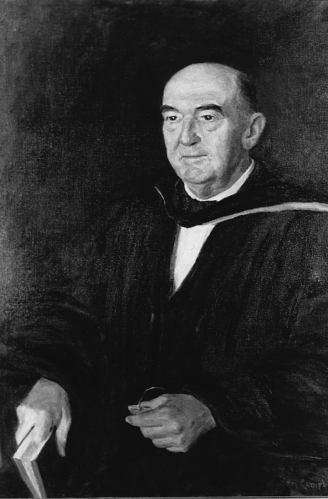
Painting of Cassius Jackson Keyser by artist Helena Eastman Ogden Campbell, ca 1920.
Image provided courtesy of the National Portrait Gallery.
Almost every modern source pairs the subject quotation in this column with a similar sounding one: “Poetry is the art of giving different names to the same thing.” Many of these modern sources go even further, making the claim that Poincaré’s quote was made as a direct response to this aphorism on poetry; however, there is no evidence in support of this claim, since “The Future of Mathematics” contains no reference to poetry at all. The original connection between these two quotations appears to be the article, “Three Great Synonyms: Relation, Transformation, Function,” by Cassius Jackson Keyser, which was first published in the journal Scripta Mathematica in 1935. In the paper, Keyser stated that he shared the Poincaré quotation with an unnamed poet, who quickly responded with the alternative quotation [Keyser 1947, p. 218]. So, according to Keyser, the quotation on poetry was in response to Poincaré, not the other way around.
References
Keyser, Cassius Jackson. 1947. Mathematics as a Culture Club and Other Essays. Vol. 1 of The Collected Works of Cassius Jackson Keyser. New York: Scripta Mathematica.
Poincaré, Henri. 1909. Science et Méthode. Paris: E. Flammarion.
Poincaré, Henri. 1913. The Foundations of Science. Translated by George Bruce Halsted. New York: Science Press.
“Quotations in Context” is a regular column written by Michael Molinsky that has appeared in the CSHPM/SCHPM Bulletin of the Canadian Society for History and Philosophy of Mathematics since 2006 (this installment was first published in November 2012). In the modern world, quotations by mathematicians or about mathematics frequently appear in works written for a general audience, but often these quotations are provided without listing a primary source or providing any information about the surrounding context in which the quotation appeared. These columns provide interesting information on selected statements related to mathematics, but more importantly, the columns highlight the fact that students today can do the same legwork, using online databases of original sources to track down and examine quotations in their original context.
Quotations in Context: Russell
“Thus mathematics may be defined as the subject in which we never know what we are talking about, nor whether what we are saying is true.”
This quotation from the logician Bertrand Russell originally appeared in an article, “Recent Work on the Principles of Mathematics,” published in 1901 by The International Monthly [Russell 1901]. Russell later included the work in his book Mysticism and Logic in 1918, where the essay in question appeared as the chapter “Mathematics and the Metaphysicians” [Russell 1918]. In this later work, he amended the original article with some corrective footnotes, reflecting changes in his understanding of some of the topics over the intervening years. Russell also admitted in the preface to Mysticism and Logic that the tone of the article was not entirely his idea, and that the editor of the magazine had urged him to make it “as romantic as possible” [Russell 1918, p. vi].
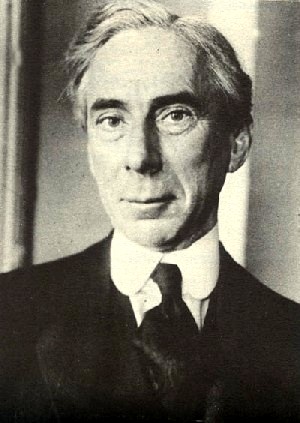
Photograph of Bertrand Russell in 1924. Public domain, Wikimedia Commons.
The article “Recent Work in the Philosophy of Mathematics” was intended for a general audience, and covered topics such as Zeno’s paradoxes of motion, infinitesimals, infinite cardinals, and the differences between Euclid’s work and that of modern geometers. The overall theme of the work concerned the definition of mathematics.
Russell opened the essay with the claim that “pure” mathematics was born in the 19th century, specifically in the work of George Boole. Pure mathematics, in this context, was defined by Russell as being identical to formal, symbolic logic. Russell argued that “pure” mathematical work is concerned only with discovering rules of valid inference; for example, given that property \(A\) is true of anything, can you safely conclude that property \(B\) is true of anything? He stated that questions about whether or not property \(A\) really is true, or what the “thing” is that we are talking about, are questions that belong to “applied” mathematics.
It was at this point in the article that the quotation appeared:
We start, in pure mathematics, from certain rules of inference, by which we can infer that if one proposition is true, then so is some other proposition. These rules of inference constitute the principles of formal logic. We then take any hypothesis that seems assuring, and deduce its consequences. If our hypothesis is about anything, and not about some one or more particular things, then our deductions constitute mathematics. Thus mathematics may be defined as the subject in which we never know what we are talking about, nor whether what we are saying is true [Russell 1901, p. 84].
Since Russell was considering mathematics as nothing but formal logic, and since he required that mathematics be distinguished from the “applied” world by concentrating on the validity of rules of inference and not the validity of the hypotheses on which those rules are used, he summed this argument up with the given quotation. In the context of the article, the quotation appears to be a somewhat tongue-in-cheek, but accurate, summation of the idea that logical rules of inference are not concerned with what the hypotheses of an argument may be or whether they are true.
In closing, I’d like to include the equally witty line that follows the quotation from the article:
People who have been puzzled by the beginnings of mathematics will, I hope, find comfort in this definition, and will probably agree that it is accurate [Russell 1901, p. 84].
References
Russell, Bertrand. 1901, July. Recent Work on the Principles of Mathematics. The International Monthly 4(1): 83–101.
Russell, Bertrand. 1918. Mysticism and Logic and Other Essays. London: Longmans, Green and Co.
“Quotations in Context” is a regular column written by Michael Molinsky that has appeared in the CSHPM/SCHPM Bulletin of the Canadian Society for History and Philosophy of Mathematics since 2006 (this installment was first published in May 2006). In the modern world, quotations by mathematicians or about mathematics frequently appear in works written for a general audience, but often these quotations are provided without listing a primary source or providing any information about the surrounding context in which the quotation appeared. These columns provide interesting information on selected statements related to mathematics, but more importantly, the columns highlight the fact that students today can do the same legwork, using online databases of original sources to track down and examine quotations in their original context.
Quotations in Context: Sylvester
“The early study of Euclid made me a hater of geometry.”
In 1869, James Joseph Sylvester was selected to serve as President of the Mathematical and Physical Sciences Section of the British Association for the Advancement of Science. Although his Presidential Address to the section meeting touched on a variety of issues, the main body of the speech was a rebuttal of a sequence of characterizations of mathematics published by Thomas Huxley that same year. In an article entitled “Scientific Education: Notes of an After-Dinner Speech,” published in MacMillian’s Magazine, Huxley emphasized the importance of observation in scientific training. By way of contrast, Huxley briefly described his view of mathematical training:
Mathematical training is almost purely deductive. The mathematician starts with a few simple propositions, the proof of which is so obvious that they are called self-evident, and the rest of his work consists of subtle deductions from them [Huxley 1869b, p. 182].
Similarly, Sylvester highlighted Huxley’s statement from “The Scientific Aspects of Positivism,” published in The Fortnightly Review, that mathematics is “that which knows nothing of observation, nothing of experiment, nothing of induction, nothing of causation” [Huxley 1869a, p. 667].
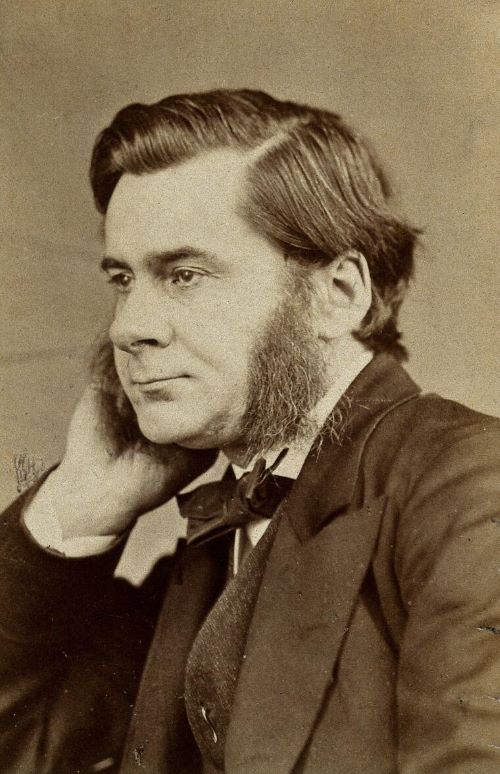
Photograph of Huxley by Elliott & Fry. Public domain, courtesy of Wellcome Collection.
Sylvester argued that Huxley could not be further from the truth. He pointed out that great mathematicians such as Lagrange and Gauss had emphasized the importance of observation in mathematics. He provided a list of mathematical ideas that originated from experiment; for example, how the motion of compound pendulums led to Sturm’s theorem regarding the number of unique real roots of a polynomial. Sylvester argued that “observation, divination, induction, experimental trial, and verification” [Sylvester 1908, p. 657] are all important aspects of mathematical training and discovery.
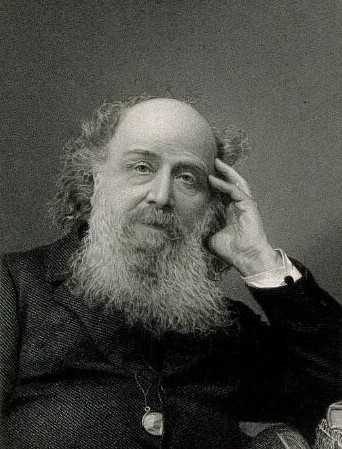
Stipple engraving of Sylvester by G. J. Stodart. Public domain, courtesy of Wellcome Collection.
Despite their difference of opinions on the nature of mathematics, Sylvester agreed with Huxley that experimental science should be introduced in schools, and he expressed a belief that mathematics could benefit from being taught in connection with science:
I think that that study [of natural and experimental science] and mathematical culture should go on hand in hand together, and that they would greatly influence each other for their mutual good. I should rejoice to see mathematics taught with that life and animation which the presence and example of her young and buoyant sister could not fail to impart, short roads preferred to long ones, Euclid honourably shelved or buried “deeper than did ever plummet sound” out of the schoolboy’s reach [Sylvester 1908, p. 657].
Following the response to Huxley, Sylvester touched on a variety of topics, but toward the end of the address he discussed the connections between arithmetic, algebra and geometry, saying that they “are constantly becoming more and more intimately related and connected by a thousand fresh ties” [Sylvester 1908, p. 659]. Sylvester particularly emphasized the importance of geometry, proclaiming the “wonderful influence geometry has exercised” [Sylvester 1908, p. 659] over modern mathematics. Having praised geometry as a general topic, Sylvester responded to those who may have been dismayed by his dismissal of Euclid from the curriculum, and it is in this context that the quotation at the head of this column appeared:
The early study of Euclid made me a hater of Geometry, which I hope may plead my excuse if I have shocked the opinions of any in this room (and I know there are some who rank Euclid as second in sacredness to the Bible alone, and as one of the advanced outposts to the British Constitution) by the tone in which I have previously alluded to it as a schoolbook; and yet, in spite of this repugnance, which had become a second nature to me, whenever I went far enough into any mathematical question, I found I touched, at last, a geometrical bottom [Sylvester 1908, p. 660].
From the material above, it can be seen that the isolated quotation for this column is both accurate and misleading. It seems quite accurate in portraying Sylvester’s actual feelings toward Euclid’s Elements, in particular to the use of that work as a geometry textbook. However, whatever his early feelings about geometry may have been, the context of the address makes it apparent that in later life he was clearly no longer a “hater” of geometry.
References
Huxley, Thomas. 1869a, June 1. The Scientific Aspects of Positivism. The Fortnightly Review 11(30): 653–670.
Huxley, Thomas. 1869b, June. Scientific Education: Notes of an After-Dinner Speech. Macmillan’s Magazine 20(116): 177–184.
Sylvester, James Joseph. 1908. The Collected Mathematical Papers of James Joseph Sylvester. Vol. 2. Cambridge: Cambridge University Press.
“Quotations in Context” is a regular column written by Michael Molinsky that has appeared in the CSHPM/SCHPM Bulletin of the Canadian Society for History and Philosophy of Mathematics since 2006 (this installment was first published in November 2007). In the modern world, quotations by mathematicians or about mathematics frequently appear in works written for a general audience, but often these quotations are provided without listing a primary source or providing any information about the surrounding context in which the quotation appeared. These columns provide interesting information on selected statements related to mathematics, but more importantly, the columns highlight the fact that students today can do the same legwork, using online databases of original sources to track down and examine quotations in their original context.
Quotations in Context: Thoreau
“He is not a true man of science who does not bring some sympathy to his studies, and expect to learn something by behavior as well as by application. It is childish to rest in the discovery of mere coincidences, or of partial and extraneous laws. The study of geometry is a petty and idle exercise of the mind, if it is applied to no larger system than the starry one. Mathematics should be mixed not only with physics but with ethics, that is mixed mathematics. The fact which interests us most is the life of the naturalist. The purest science is still biographical.”
Naturalist Henry David Thoreau published A Week on the Concord and Merrimack Rivers at his own expense in 1849. The book related events from a trip taken a decade earlier by Thoreau and his brother John through Massachusetts and New Hampshire, combined with selections of poetry and Thoreau’s views on a wide range of topics. Although the actual trip lasted two weeks, the book itself is organized around a single week, starting with the last Saturday in August 1839 and proceeding through the following Friday.
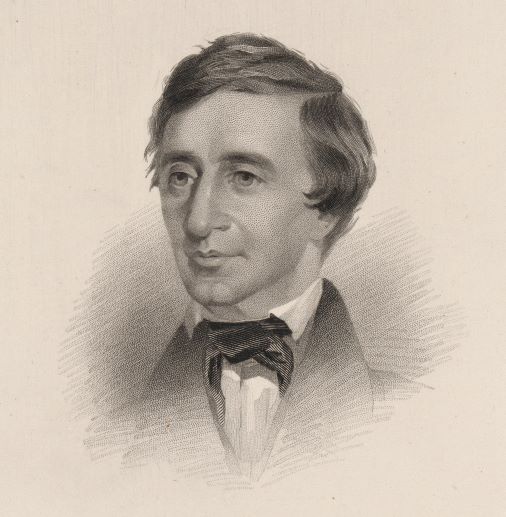
Engraving of Thoreau by unknown artist, based on work of Samuel Rowse. Public domain, National Portrait Gallery.
It was on this last day, Friday, when Thoreau’s thoughts turned to mathematics. On the previous Sunday, Thoreau and his brother had encountered a “lover of the higher mathematics” [Thoreau 1849, p. 84] who was called away from consideration of an unspecified mathematical problem in order to let their boat through the locks onto the Merrimack, and on Friday they met the same individual again on their return trip. This meeting apparently inspired Thoreau to consider mathematics and science, and particularly their relation to truth and beauty, as he stated that appreciation of the beauty of scientific truth is much rarer than the appreciation of moral truth. He then switched specifically to mathematics:
We have heard much about the poetry of mathematics, but very little of it has yet been sung. The ancients had a juster notion of their poetic value than we. The most distinct and beautiful statement of any truth must take at last the mathematical form. We might so simplify the rules of moral philosophy, as well as of arithmetic, that one formula would express them both [Thoreau 1849, p. 381].
Thoreau extended this claim, emphasizing the connection between moral laws and natural philosophy, and he argued for strong interaction and connection between scientific and ethical truth. It was at this point in the book that the quotation at the beginning of this column appears [Thoreau 1849, pp. 381–382].
In the following paragraphs, Thoreau explored additional topics, such as the process of scientific discovery and the particular need for genius, arguing that “the power to perceive a law is equally rare in all the ages of the world” [Thoreau 1849, p. 384]. Before returning to the description of the final stages of his journey down to Concord, Thoreau briefly related an account of the voyage of Sir James Clark Ross to Antarctica, including the fact that the crews were given additional rations of grog as a reward for reaching further south than any before. Thoreau concluded by using this story to return to his point about the importance of genius over the mere collection of facts:
Let not us sailors of late centuries take upon ourselves any airs on account of our Newtons and our Cuviers; we deserve an extra allowance of grog only [Thoreau 1849, p. 385].
Reference
Thoreau, Henry David. 1849. A Week on the Concord and Merrimack Rivers. Boston: James Munroe and Company.
“Quotations in Context” is a regular column written by Michael Molinsky that has appeared in the CSHPM/SCHPM Bulletin of the Canadian Society for History and Philosophy of Mathematics since 2006 (this installment was first published in May 2016). In the modern world, quotations by mathematicians or about mathematics frequently appear in works written for a general audience, but often these quotations are provided without listing a primary source or providing any information about the surrounding context in which the quotation appeared. These columns provide interesting information on selected statements related to mathematics, but more importantly, the columns highlight the fact that students today can do the same legwork, using online databases of original sources to track down and examine quotations in their original context.
Quotations in Context: Tolstoy
“A man is like a fraction whose numerator is what he is
and whose denominator is what he thinks of himself.
The larger the denominator the smaller the fraction.”
The quotation above has appeared in many publications in the 21st century, always attributed to Russian author Count Lev Nikolayevich Tolstoy (more widely known as Leo Tolstoy). The few citations provided for the quotation can all be traced back to a book published by Howard W. Eves, Return to Mathematical Circles [Eves 1988, p. 81]. Unfortunately, Eves provided no information on the original source of the quotation, and I have found no publication before 1988 that contains the same wording that Eves provides.
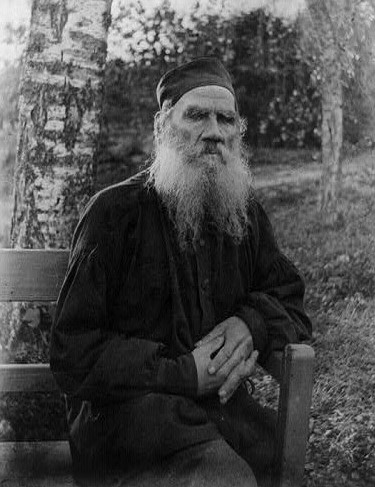
Photograph of Tolstoy, 1897. Public domain, Library of Congress.
One possible source that Eves may have used is a letter Tolstoy wrote a mere fifteen days before his death. Tolstoy was formally excommunicated from the Russian Orthodox Church in 1901, but the Church did not completely abandon him; in particular, Father Dimitri Troitsky continued to visit Tolstoy even after his excommunication in an effort to convince him to repent and return. When Tolstoy’s health began to fail in October 1910, Troitsky wrote to Tolstoy urging him to seek the support and guidance of the Church before it was too late. While Tolstoy politely but firmly refused this plea, their conversation continued through a few more letters. In the first paragraph of a brief reply written on November 5, Tolstoy laid out a comparison of a man to a fraction, in a manner not identical but still clearly related to the comparison that was attributed to him by Eves.
The English translation of the paragraph below is from the article “The Last Days of Leo Tolstoy" by Alexander Kaun, published in the Atlantic Monthly in March 1922:
I have received your letter, Dimitri Yegorovich, and thank you for it. I perfectly agree with you that humility is the greatest and most needful virtue. As I always say, man is like a fraction, in which the denominator indicates his opinion of himself. It is best for this denominator to be zero (complete humility), and it is terrible when it is augmented to infinity. In the first case, man has a true significance, whatever the denominator; but in the second case—none [Kaun 1922, p. 301].
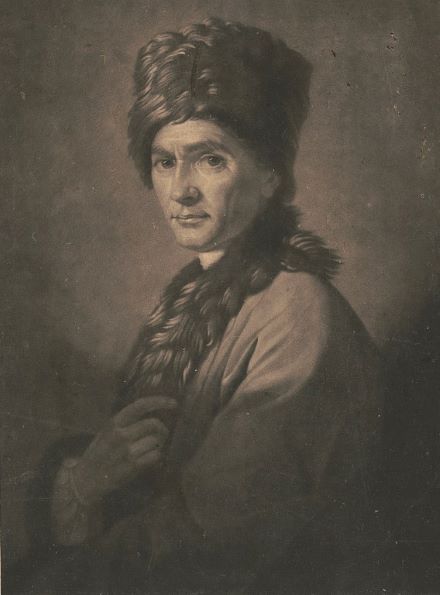
Engraving of Rousseau by David Martin, based on painting by Allan Ramsay, 1766.
Public domain, Library of Congress.
While trying to track down the source of the Tolstoy quotation, I ran across an interesting earlier comparison between humans and fractions by the political philosopher Jean-Jacques Rousseau in his work Émile, ou De l’éducation, published in 1762. While Tolstoy promoted the importance of humility, Rousseau instead used a fraction metaphor to illustrate the competing goals of society and the individual:
L'homme naturel est tout pour lui: il est l'unité numérique, l'entier absolu, qui n'a de rapport qu'à lui-même ou à fon semblable. L'homme civil n'est qu’une unité fractionnaire qui tient au dénominateur, & dont la valeur est dans son rapport avec l'entier, qui est le corps social. Les bonnes institutions sociales sont celles qui savent le mieux dénaturer l'homme, lui ôter son existence absolue pour lui en donner une relative, & transporter le moi dans l'unité commune; en sorte que chaque particulier ne se croye plus un, mais partie de l’unité, & ne foit plus sensible que dans le tout [Rousseau 1762, p. 6].
The natural man lives for himself; he is the unit, the whole, dependent only on himself and on his like. The citizen is but the numerator of a fraction, whose value depends on its denominator; his value depends upon the whole, that is, on the community. Good social institutions are those best fitted to make a man unnatural, to exchange his independence for dependence, to merge the unit in the group, so that he no longer regards himself as one, but as a part of the whole, and is only conscious of the common life [Rousseau 1925, p. 7].
References
Eves, Howard W. 1988. Return to Mathematical Circles. Boston: PWS-Kent Publishing Company.
Kaun, Alexander. 1922, March. The Last Days of Leo Tolstoy: With Translations From His Diary and Letters. The Atlantic 129(3): 299-306.
Rousseau, Jean Jacques. 1762. Émile, ou De L’éducation. Vol. 1. Paris.
Rousseau, Jean Jacques. 1925. Emile or Education by J. J. Rousseau. Translated by Barbara Foxley. London: J. M. Dent & Sons, Ltd.
“Quotations in Context” is a regular column written by Michael Molinsky that has appeared in the CSHPM/SCHPM Bulletin of the Canadian Society for History and Philosophy of Mathematics since 2006 (this installment was first published in November 2014). In the modern world, quotations by mathematicians or about mathematics frequently appear in works written for a general audience, but often these quotations are provided without listing a primary source or providing any information about the surrounding context in which the quotation appeared. These columns provide interesting information on selected statements related to mathematics, but more importantly, the columns highlight the fact that students today can do the same legwork, using online databases of original sources to track down and examine quotations in their original context.
Quotations in Context: Voltaire
“There are no sects in geometry.”
“He who has heard the same thing told by 12,000 eye-witnesses
has only 12,000 probabilities, which are equal to one strong probability,
which is far from certain.”
In 1764 a collection of 73 articles on a variety of topics was published anonymously under the title Dictionnaire philosophique portatif. The writing was informal and often in the first person, and the work would be more accurately described as a collection of essays rather than as a dictionary. Despite being proscribed by the Catholic Church as well as burned in Paris and other cities, the work proved extremely popular: it was reprinted five times and expanded to include additional articles. The final version was published in 1769 under the title Dictionnaire philosophique. It was years later before it became widely known that the author of the work had been François-Marie d'Arouet, better known as Voltaire.

Lithograph of Voltaire. Public domain, Wellcome Collection.
It was in the opening lines of the article “Sect” that the first quotation from the beginning of this column appears:
Toute secte, en quelque genre que ce puisse être, est le ralliement du doute et de l'erreur. Scotistes, thomistes, réaux, nominaux, papistes, calvinistes, molinistes, jansenistes, ne sont que des noms de guerre. Il n'y a point de secte en géométrie; on ne dit point un euclidien, un archimédien. Quand la vérité est évidente, il est impossible qu'il s'élève des partis et des factions. Jamais on n'a disputé s'il fait jour à midi [Voltaire 1821, p. 129].
Every sect, in whatever sphere, is the rallying-point of doubt and error. Scotist, Thomist, Realist, Nominalist, Papist, Calvinist, Molinist, Jansenist, are only pseudonyms. There are no sects in geometry; one does not speak of a Euclidian [sic], an Archimedean. When the truth is evident, it is impossible for parties and factions to arise. Never has there been a dispute as to whether there is daylight at noon [Voltaire 1924, p. 267].
While it was true at the time it was written that “one does not speak of a Euclidean,” of course it is now commonplace to discriminate between Euclidean geometry and non-Euclidean geometries such as hyperbolic geometry. However, the actual meaning of Voltaire’s quotation still seems to hold true today: unlike religious sects, modern mathematicians do not argue that Euclidean or non-Euclidean geometry is the one “true” geometry, but only that each is equally consistent as a mathematical system.
Voltaire came back to this same point about sects in geometry at the end of the article “Tolerance,” generalizing to include other branches of mathematics:
C'est ainsi qu'on en usa long-temps dans une grande partie de la terre; mais aujourd'hui que tant de sectes se balancent par leur pouvoir, quel parti prendre avec elles? toute secte, comme on sait, est un titre d'erreur il n'y a point de secte de géomètres, d'algébristes, d'arithméticiens, parce que toutes les propositions de géométrie, d'algèbre, d'arithmétique, sont vraies. Dans toutes les autres sciences on peut se tromper [Voltaire 1821, p. 310].
It is thus that a great part of the world long was treated; but today when so many sects make a balance of power, what course to take with them? Every sect, as one knows, is a ground of error; there are no sects of geometers, algebraists, arithmeticians, because all the propositions of geometry, algebra and arithmetic are true. In every other science one may be deceived [Voltaire 1924, p. 304].
The second quotation at the beginning of this column came from the article “Truth,” which opened by relating the Biblical story of Pontius Pilate asking, “What is truth?” and then immediately leaving the room. Voltaire lamented Pilate’s lack of intellectual curiosity, and proceeded to imagine a lengthy training regimen for him: at least six months of logic, three or more years of geometry, a year of physics, as well as additional years of theology and metaphysics. Once this training was complete, Voltaire concluded:
I should then have said to Pilate:—Historical truths are merely probabilities. If you had fought at the battle of Philippi, that is for you a truth which you know by intuition, by perception. But for us who dwell near the Syrian desert, it is merely a very probable thing, which we know by hearsay. How much hearsay is necessary to form a conviction equal to that of a man who, having seen the thing, can flatter himself that he has a sort of certainty?
He who has heard the thing told by twelve thousand eye-witnesses, has only twelve thousand probabilities, equal to one strong probability, which is not equal to certainty.
If you have the thing from only one of these witnesses, you know nothing; you should be sceptical. If the witness is dead, you should be still more sceptical, for you cannot enlighten yourself. If from several witnesses who are dead, you are in the same plight. If from those to whom the witnesses have spoken, your scepticism should increase still more.
From generation to generation scepticism increases, and probability diminishes; and soon probability is reduced to zero [Voltaire 1924, pp. 306–307].
(Note: the original French for this longer selection can be found on pages 369–370 of [Voltaire 1821].)
The Dictionnaire philosophique contains many other mathematical references besides the two most common quotations that this column has traced. As an example, I’ll conclude with my personal favorite, which appears in the “Contradictions” article:
Je ne connais que deux sortes d'êtres immuables sur la terre, les géomètres & les animaux; ils sont conduits par deux règles invariables, la démonstration & l'instinct: & encore les géomètres ont-ils eu quelques disputes, mais les animaux n'ont jamais varié [Voltaire 1784, p. 124].
I know only two kinds of immutable beings on the earth, mathematicians and animals; they are led by two invariable rules, demonstration and instinct: and even the mathematicians have had some disputes, but the animals have never varied [Voltaire 1924, p. 83].
References
Voltaire. 1784. Oeuvres Completes de Voltaire. Vol 39. [Kehl, Germany]: Société littéraire-typographique.
Voltaire. 1821. Oeuvres de Voltaire. Vol. 8. Paris: Garnery.
Voltaire. 1924. Voltaire’s Philosophical Dictionary. Translated by H. I. Woolf. New York: A. A. Knopf.
“Quotations in Context” is a regular column written by Michael Molinsky that has appeared in the CSHPM/SCHPM Bulletin of the Canadian Society for History and Philosophy of Mathematics since 2006 (this installment was first published in May 2011). In the modern world, quotations by mathematicians or about mathematics frequently appear in works written for a general audience, but often these quotations are provided without listing a primary source or providing any information about the surrounding context in which the quotation appeared. These columns provide interesting information on selected statements related to mathematics, but more importantly, the columns highlight the fact that students today can do the same legwork, using online databases of original sources to track down and examine quotations in their original context.
Quotations in Context: Whitehead
“Everything of importance has been said before
by somebody who did not discover it.”
Another Quotations in Context column addresses a quotation from James Joseph Sylvester’s Presidential Address in 1869 to the Mathematical and Physical Sciences Section of the British Association for the Advancement of Science. In 1916, Alfred North Whitehead gave his own Presidential Address to this same institution. The topic of his speech was “The Organisation of Thought.”
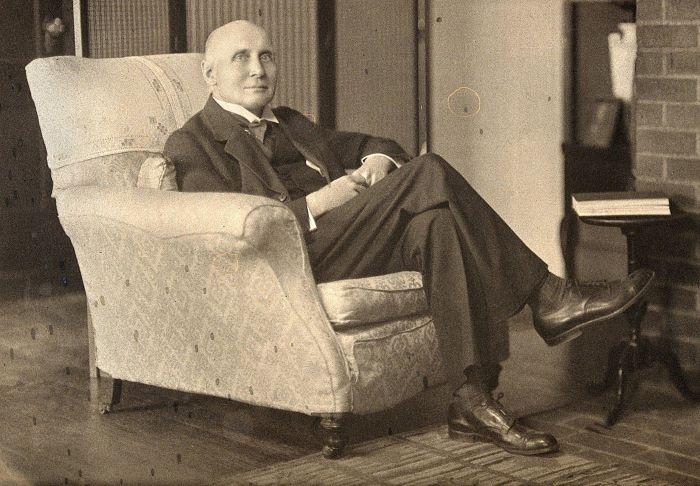
Photograph of Whitehead. Public domain, courtesy of Wellcome Collection.
The first half of his address was about the nature of science. Whitehead discussed the practical and theoretical sides of science, the discipline’s use of inductive reasoning and experience, and its foundation in common sense. In the end, he concluded:
Science is essentially logical. The nexus between its concepts is a logical nexus, and the grounds for its detailed assertions are logical grounds. King James said, 'No bishops, no king.' With greater confidence we can say, 'No logic, no science' [Whitehead 2007a].
The speech briefly turned to those who viewed logical thought as barren or sterile. He mentioned the belief that deductive reasoning could not create new ideas, since any conclusions came part and parcel with the premises with which one began. Whitehead offered a brief rebuttal to this characterization, but he then moved on, although he would address this topic again later in the speech.
Whitehead gave a brief overview of modern logic, dividing it into four general sections, which he termed arithmetic, algebra, general-function theory and analytic. The arithmetic section involved general propositions, while the algebra section introduced propositional functions. The general-function theory section then considered classes of propositional functions. The final section, the analytic stage, Whitehead concluded as being the “whole of mathematics . . . neither more nor less” [Whitehead 2007b].
The quotation in question for this column appeared immediately following this summary and categorization of logical thought, when Whitehead returned to the idea of the barrenness of logic:
The question arises, How many forms of propositions are there? The answer is, an unending number. The reason for the supposed sterility of logical science can thus be discerned. Aristotle founded the science by conceiving the idea of the form of a proposition, and by conceiving deduction as taking place in virtue of the forms. But he confined propositions to four forms, now named A, I, E, O. So long as logicians were obsessed by this unfortunate restriction, real progress was impossible. Again, in their theory of form, both Aristotle and subsequent logicians came very near to the theory of the logical variable. But to come very near to a true theory, and to grasp its precise application, are two very different things, as the history of science teaches us. Everything of importance has been said before by somebody who did not discover it [Whitehead 2007b].
I have occasionally found Whitehead’s quotation being misinterpreted as equivalent to Stephen Stigler’s “law of eponymy.” But in the context of the original address, Whitehead clearly seems to be saying the exact opposite: that the first person to state a result or make a claim is rarely the first person to truly understand the idea precisely and completely.
References
Whitehead, Alfred North. 2007a, April. A. N. Whitehead addresses the British Association in 1916, Part 1. MacTutor History of Mathematics Archive.
Whitehead, Alfred North. 2007b, April. A. N. Whitehead addresses the British Association in 1916, Part 2. MacTutor History of Mathematics Archive.
“Quotations in Context” is a regular column written by Michael Molinsky that has appeared in the CSHPM/SCHPM Bulletin of the Canadian Society for History and Philosophy of Mathematics since 2006 (this installment was first published in November 2008). In the modern world, quotations by mathematicians or about mathematics frequently appear in works written for a general audience, but often these quotations are provided without listing a primary source or providing any information about the surrounding context in which the quotation appeared. These columns provide interesting information on selected statements related to mathematics, but more importantly, the columns highlight the fact that students today can do the same legwork, using online databases of original sources to track down and examine quotations in their original context.
Quotations in Context: About the Author
Michael Molinsky is a Professor of Mathematics at the University of Maine at Farmington, the oldest public institution of higher education in Maine, where he encourages his students (especially those preparing to be K–12 teachers) to explore the history of mathematics. He is an active member of the Canadian Society for History and Philosophy of Mathematics, and he served as an Associate Editor of Convergence from 2017 through 2022.